Just birds - RNR 3018 Spring 2024
1/166
Earn XP
Name | Mastery | Learn | Test | Matching | Spaced |
|---|
No study sessions yet.
167 Terms
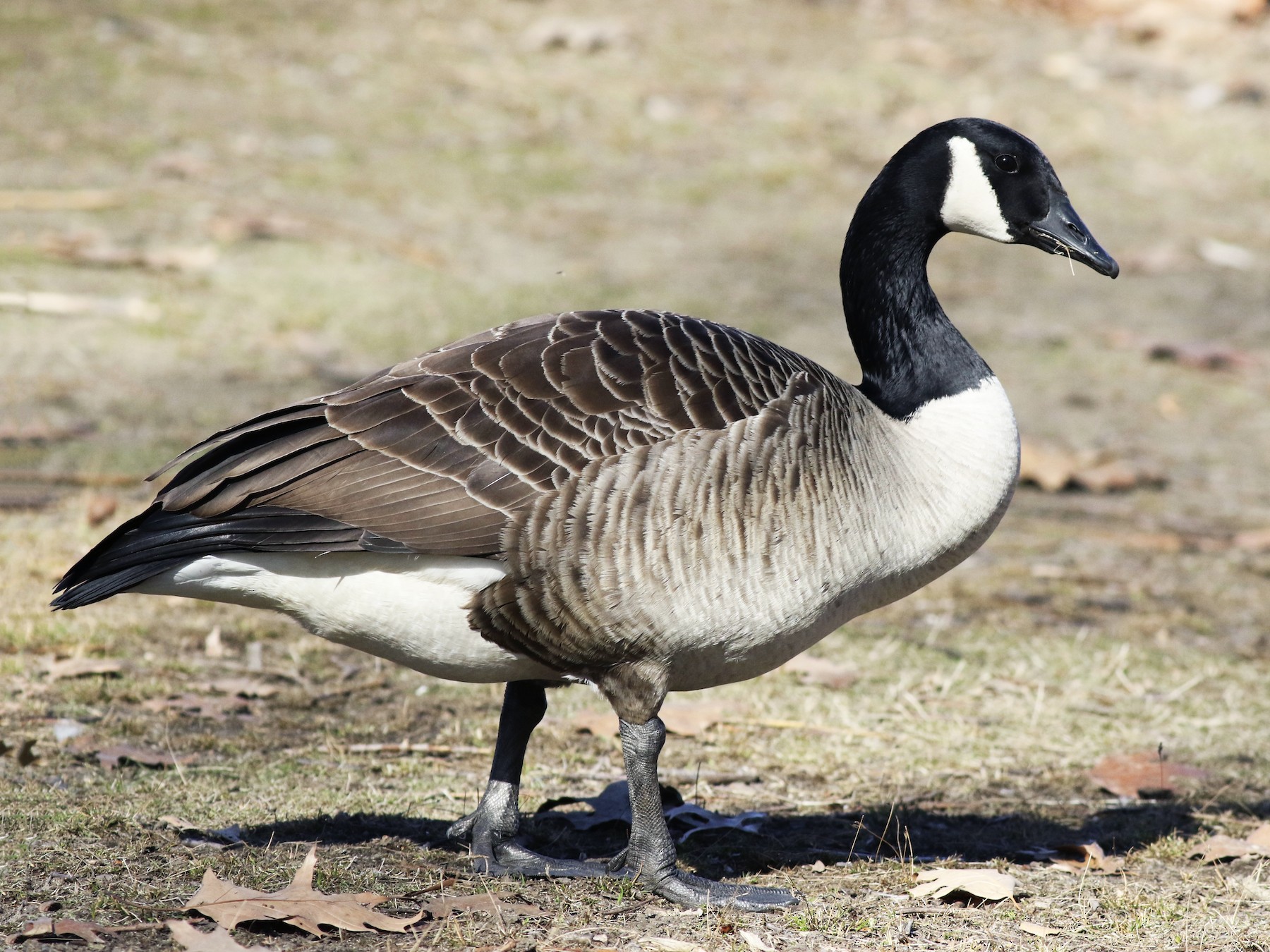
Canada Goose, Branta canadensis - A large waterfowl species native to North America, known for its distinctive black head and long neck with white cheek patches. (Not to be confused with the Cackling Goose)
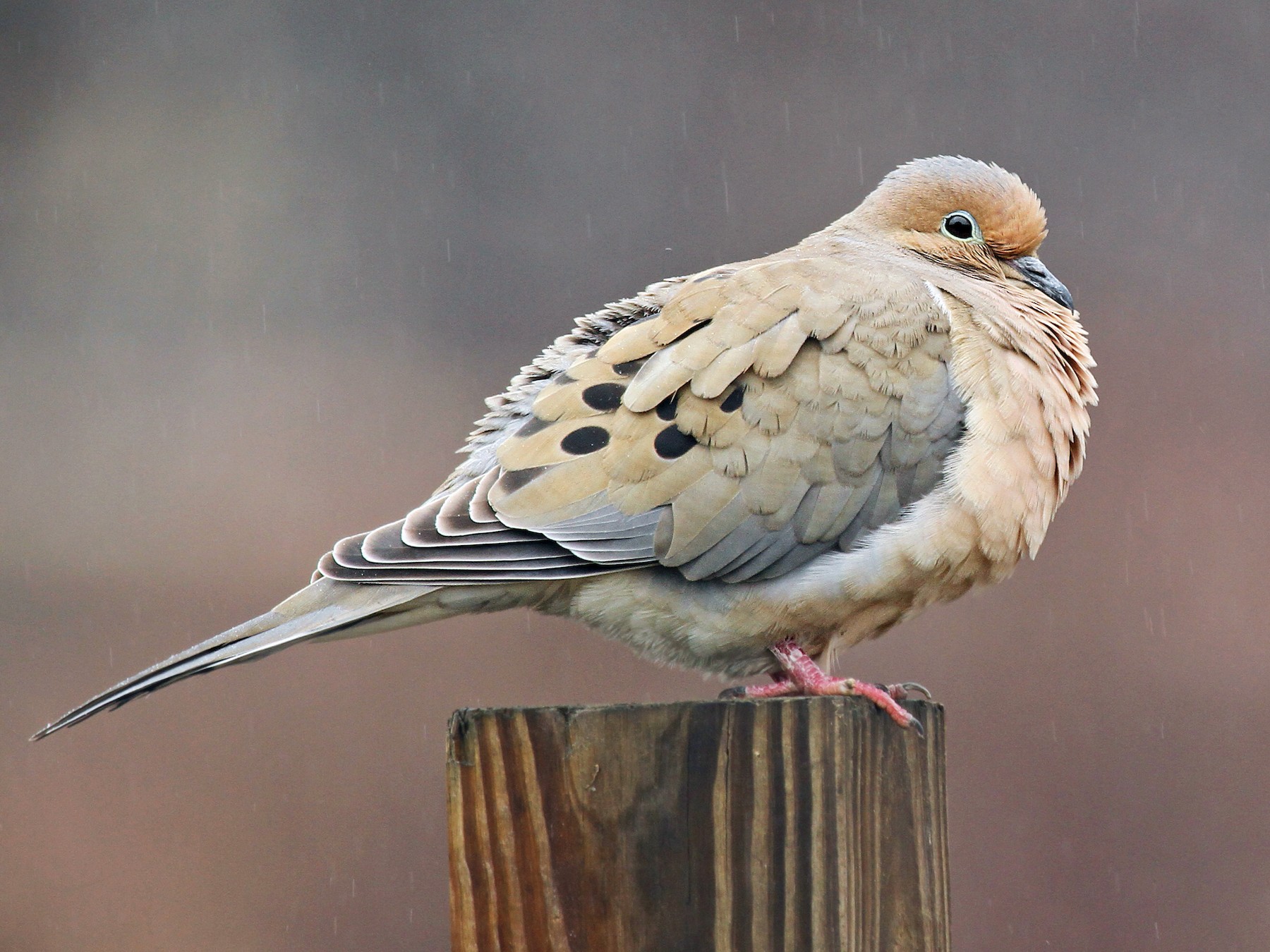
Mourning Dove, Zenaida macroura - A medium-sized bird with a soft, mournful cooing call, commonly found in North America.
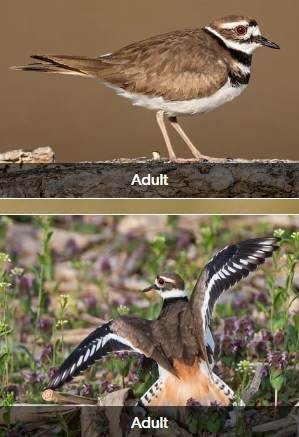
Killdeer, Charadrius vociferus - A medium-sized plover species known for its loud, piercing call and distinctive black and white plumage.
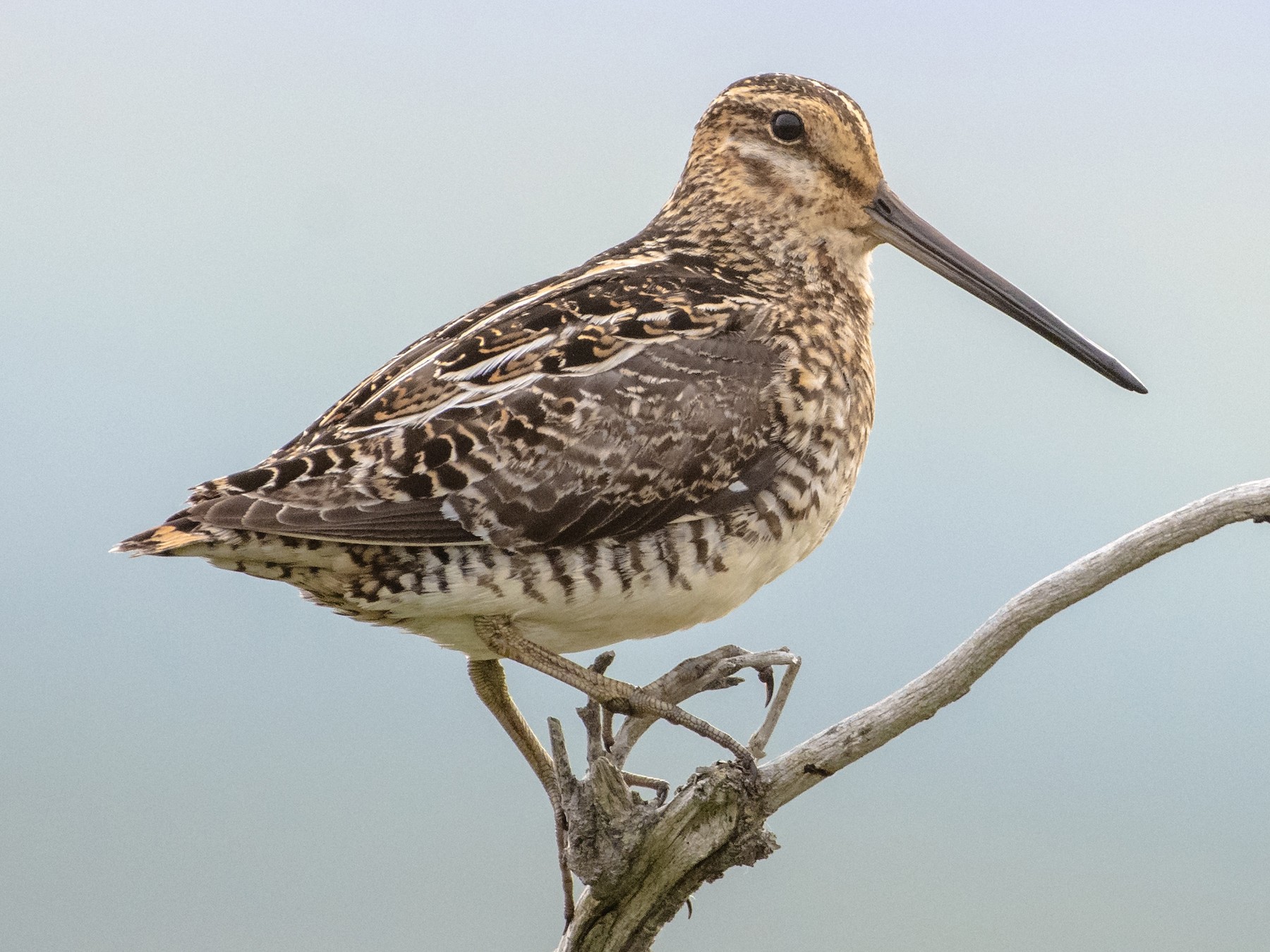
Wilson's Snipe, Gallinago delicata - A medium-sized shorebird with a long bill, known for its drumming sound produced during courtship flights.
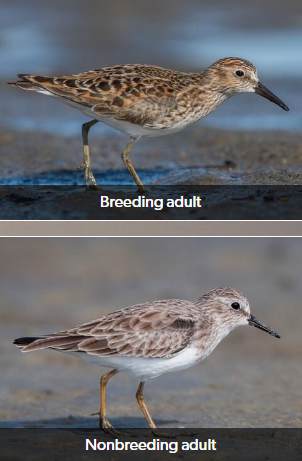
Least Sandpiper, Calidris minutilla - A small shorebird species with a short bill, commonly found in wetland habitats.
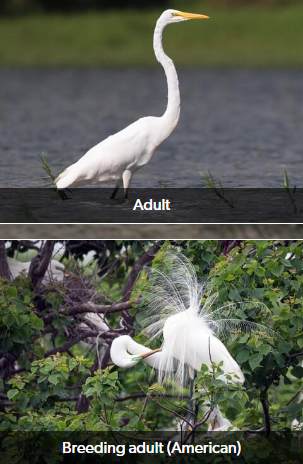
Great Egret, Ardea alba - A large wading bird with a long neck and white plumage, often seen in marshes and wetlands.
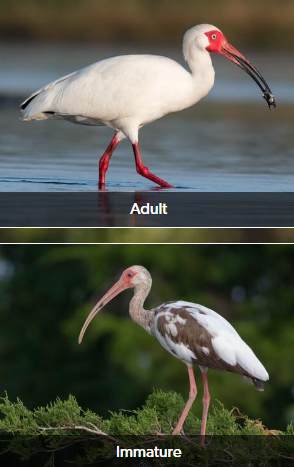
White Ibis, Eudocimus albus - A medium-sized wading bird with a long, curved bill and white plumage, commonly found in coastal areas.
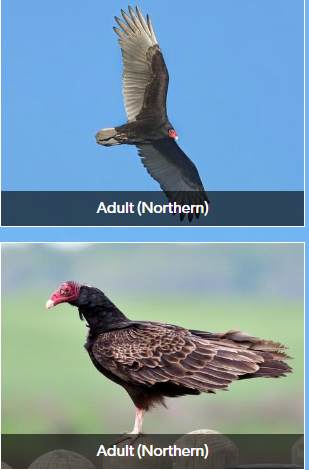
Turkey Vulture, Cathartes aura - A large bird of prey with a bald head and dark plumage, known for its scavenging behavior.

Red-tailed Hawk, Buteo jamaicensis - A large bird of prey with a reddish-brown tail and a distinctive screeching call, commonly found in North America.
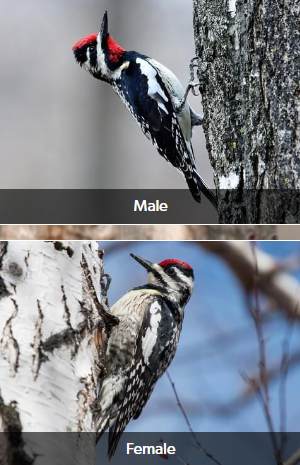
Yellow-bellied Sapsucker, Sphyrapicus varius - A small woodpecker species with a yellow belly and a habit of drilling holes in trees to feed on sap.
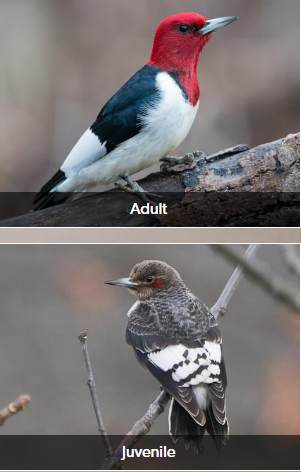
Red-headed Woodpecker, Melanerpes erythrocephalus - A medium-sized woodpecker with a bright red head and black and white plumage, known for its acrobatic flight.
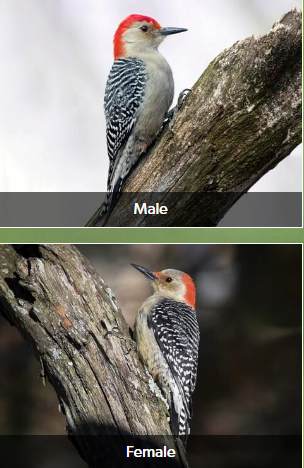
Red-bellied Woodpecker, Melanerpes carolinus - A medium-sized woodpecker with a red cap and a pale belly, commonly found in wooded areas.
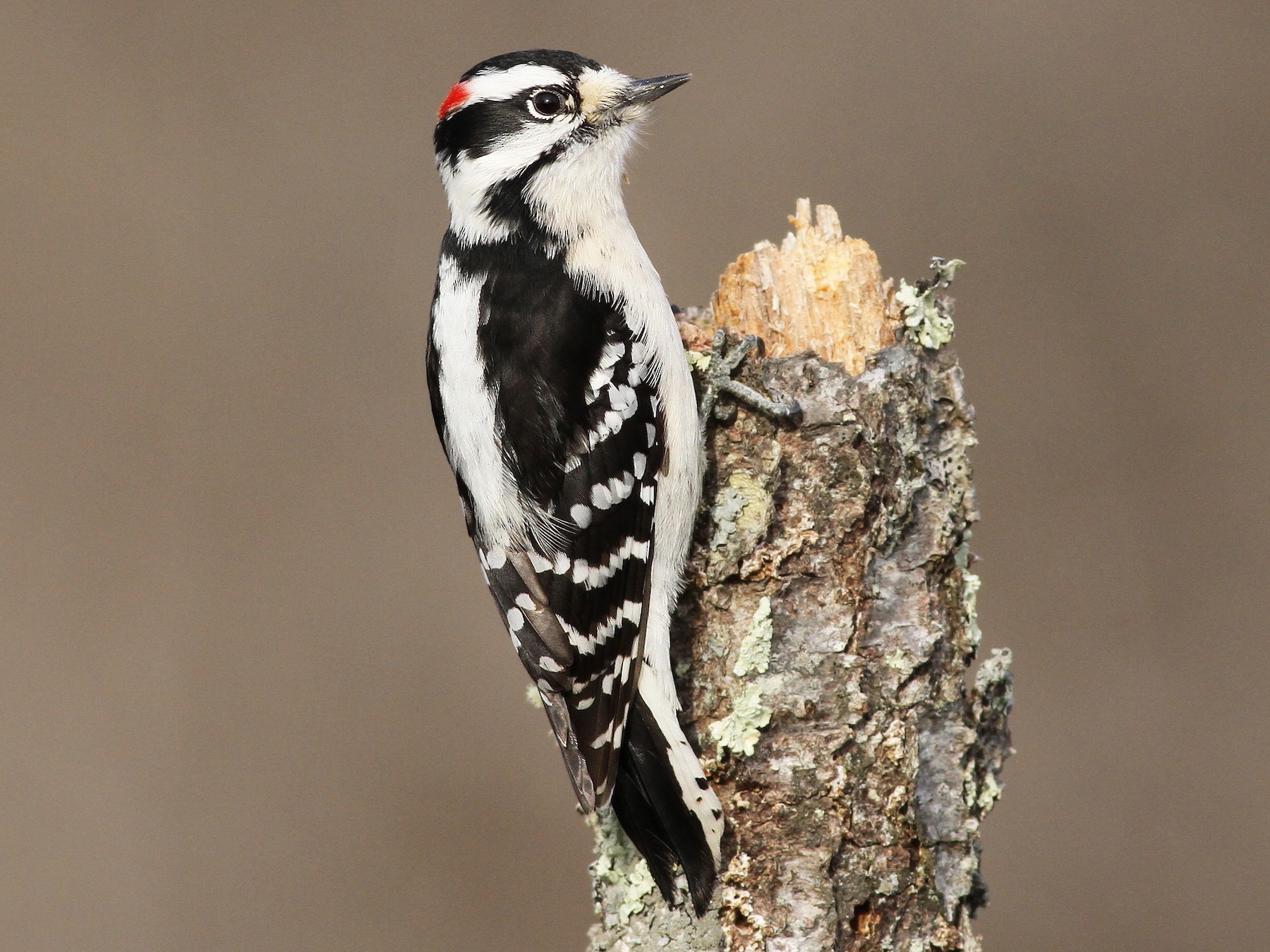
Downy Woodpecker, Dryobates pubescens - A small woodpecker species with a black and white plumage and a short bill, commonly found in forests and woodlands.
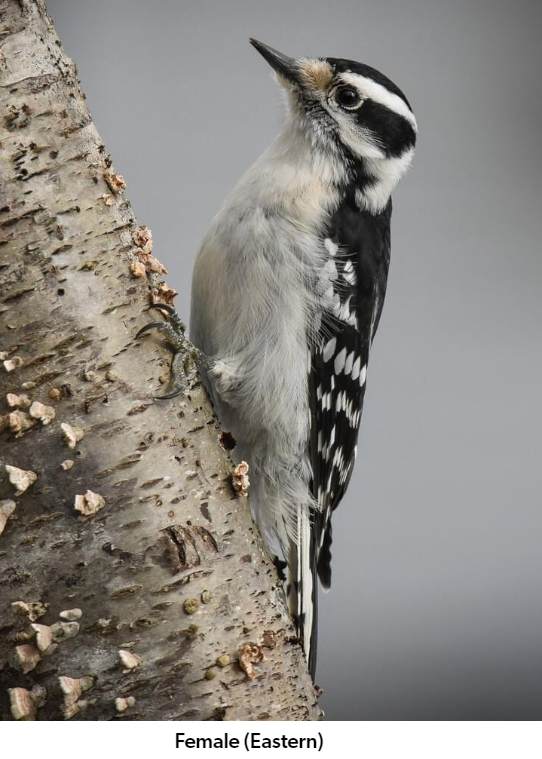
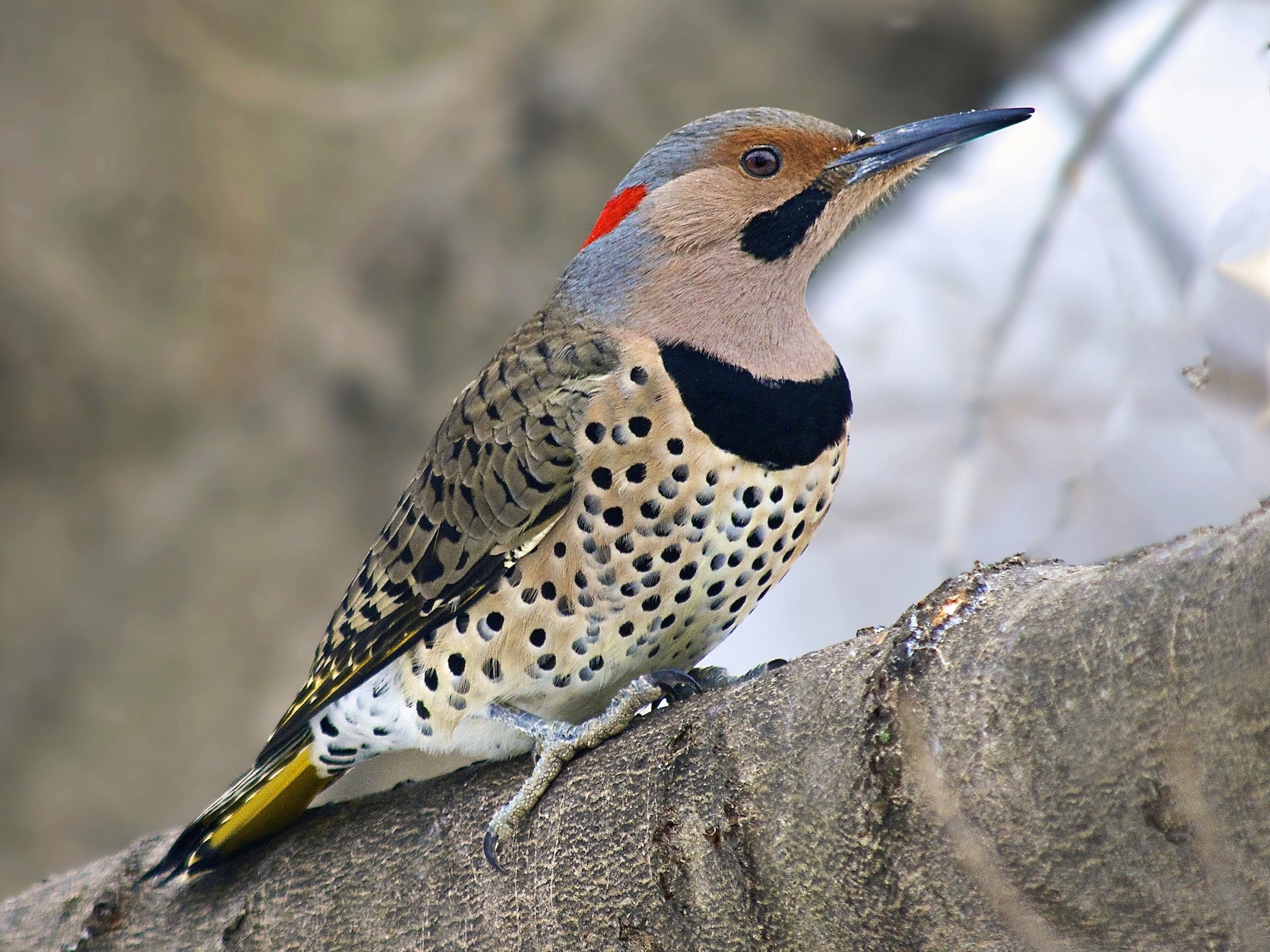
Northern Flicker, Colaptes auratus - A medium-sized woodpecker with a brown plumage and a distinctive "flickering" flight pattern, commonly found in open woodlands. Both male and female can be red or yellow shafted (red or yellow on shaft of wings and tail). Yellow-shafted females lack the black mustache mark of males.
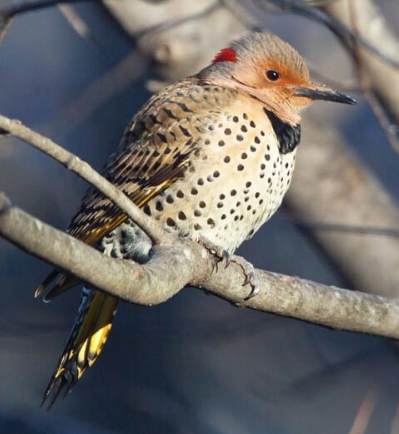
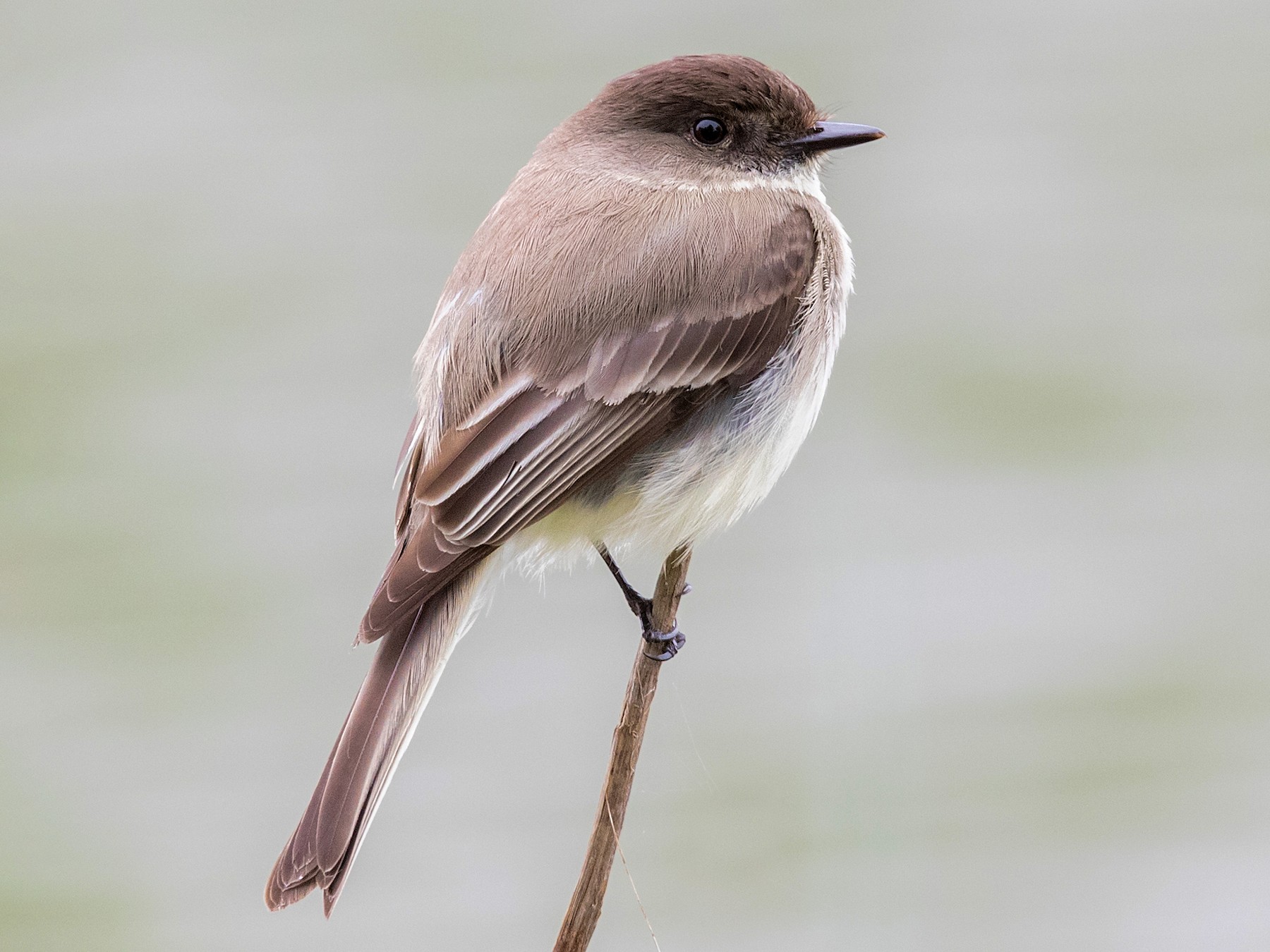
Eastern Phoebe, Sayornis phoebe - A small flycatcher species with a dark head and a habit of wagging its tail, commonly found in eastern North America.

Loggerhead Shrike, Lanius ludovicianus - A medium-sized songbird with a hooked bill and a habit of impaling its prey on thorns or barbed wire.
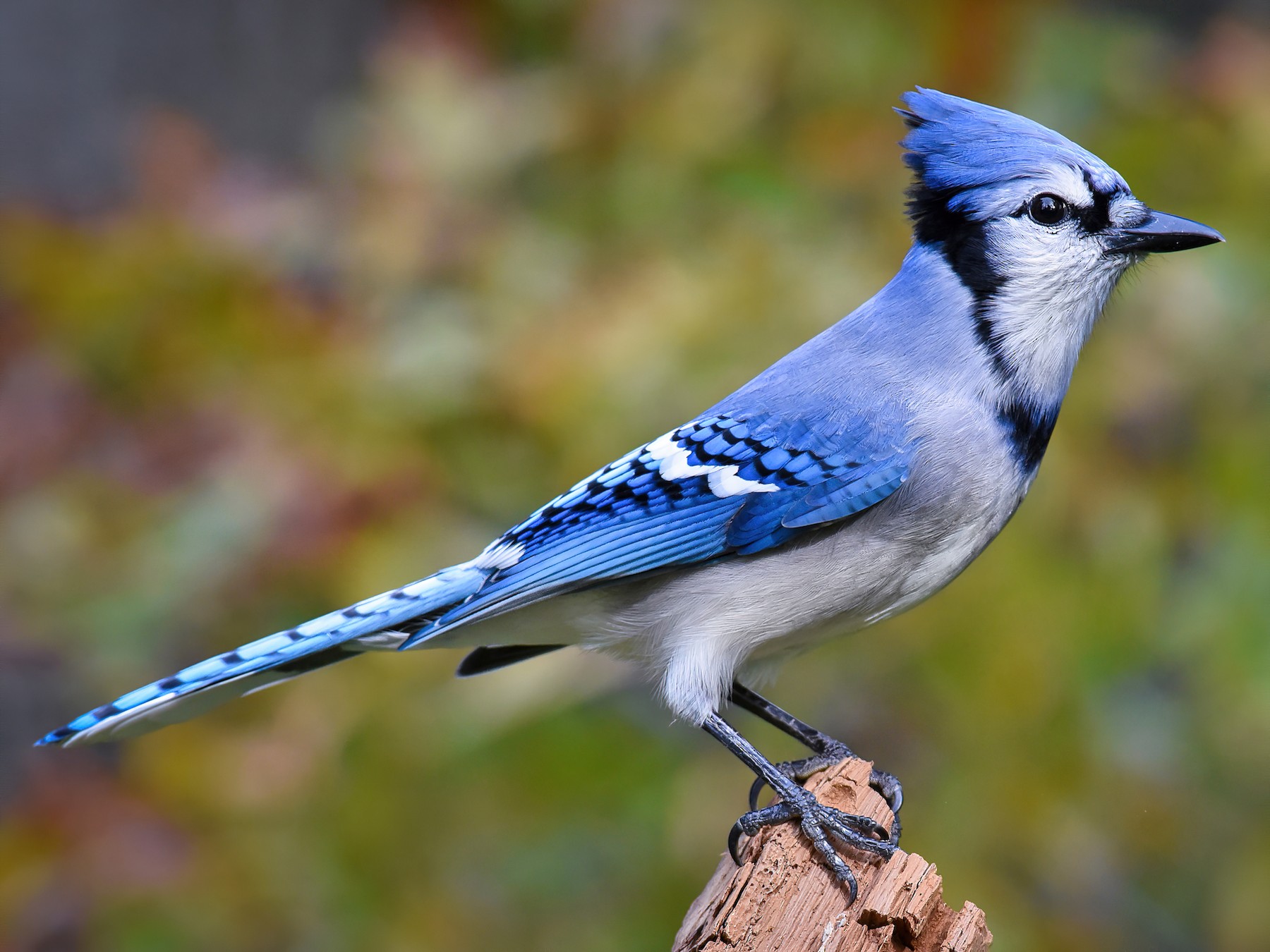
Blue Jay, Cyanocitta cristata - A medium-sized songbird with a blue plumage and a crest on its head, known for its loud, harsh calls.
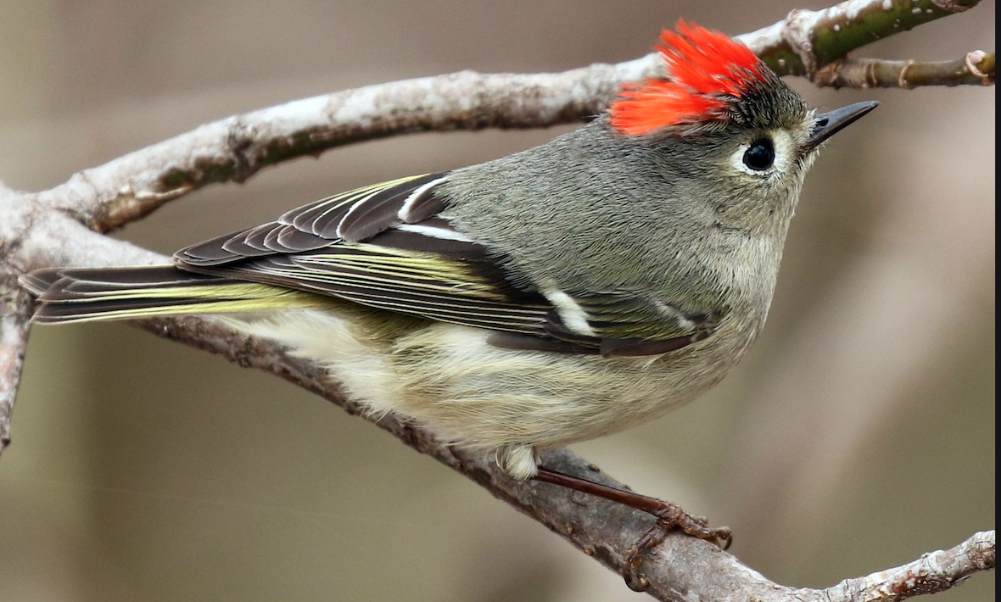
Ruby-crowned Kinglet, Corthylio calendula - A small songbird with a greenish-gray plumage and a ruby-red crown patch, commonly found in coniferous forests.
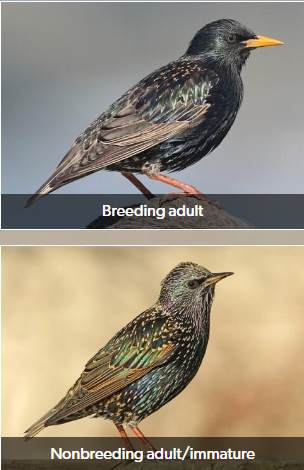
European Starling, Sturnus vulgaris - A medium-sized songbird with a black plumage and a habit of mimicking other bird species' calls, introduced to North America from Europe.
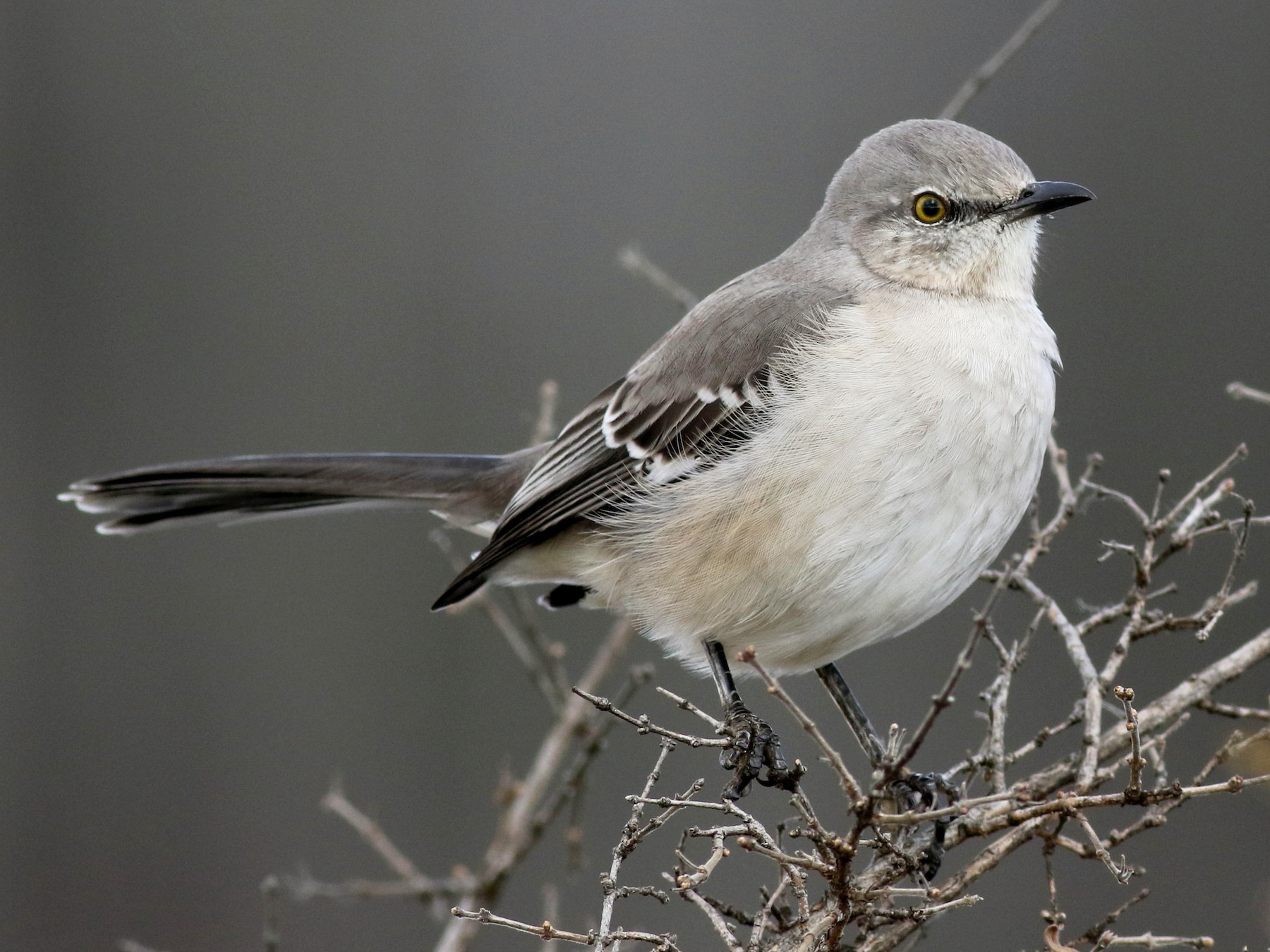
Northern Mockingbird, Mimus polyglottos - A medium-sized songbird with a gray plumage and a remarkable ability to mimic the songs of other bird species.
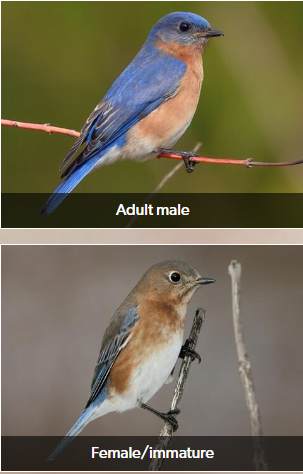
Eastern Bluebird, Sialia sialis - A small thrush species with a blue upper body and a rusty-red breast, commonly found in open woodlands and fields.
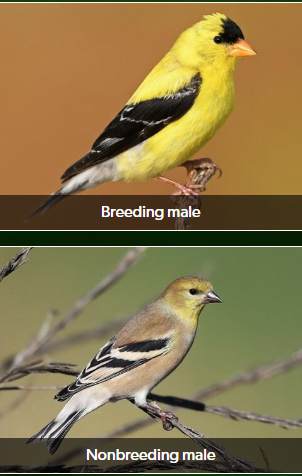
American Goldfinch, Spinus tristis - A small songbird with a bright yellow plumage and a distinctive flight call, commonly found in North America. Females lack breeding male’s black forehead.
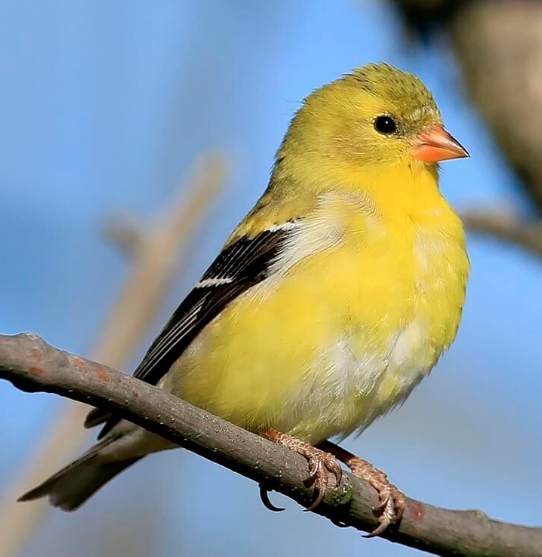
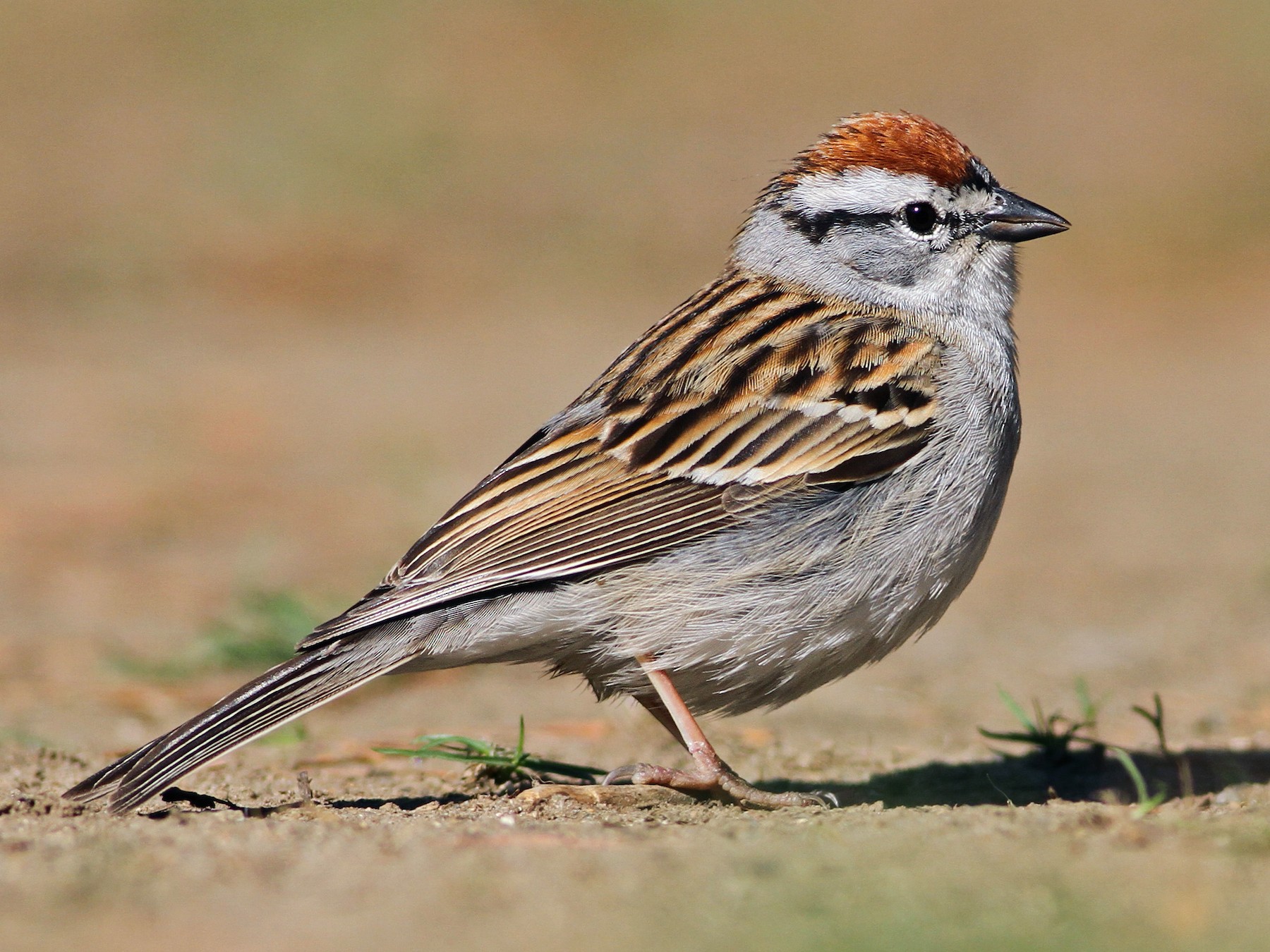
Chipping Sparrow, Spizella passerina - A small sparrow species with a reddish-brown cap and a habit of making a "chipping" sound, commonly found in open woodlands.
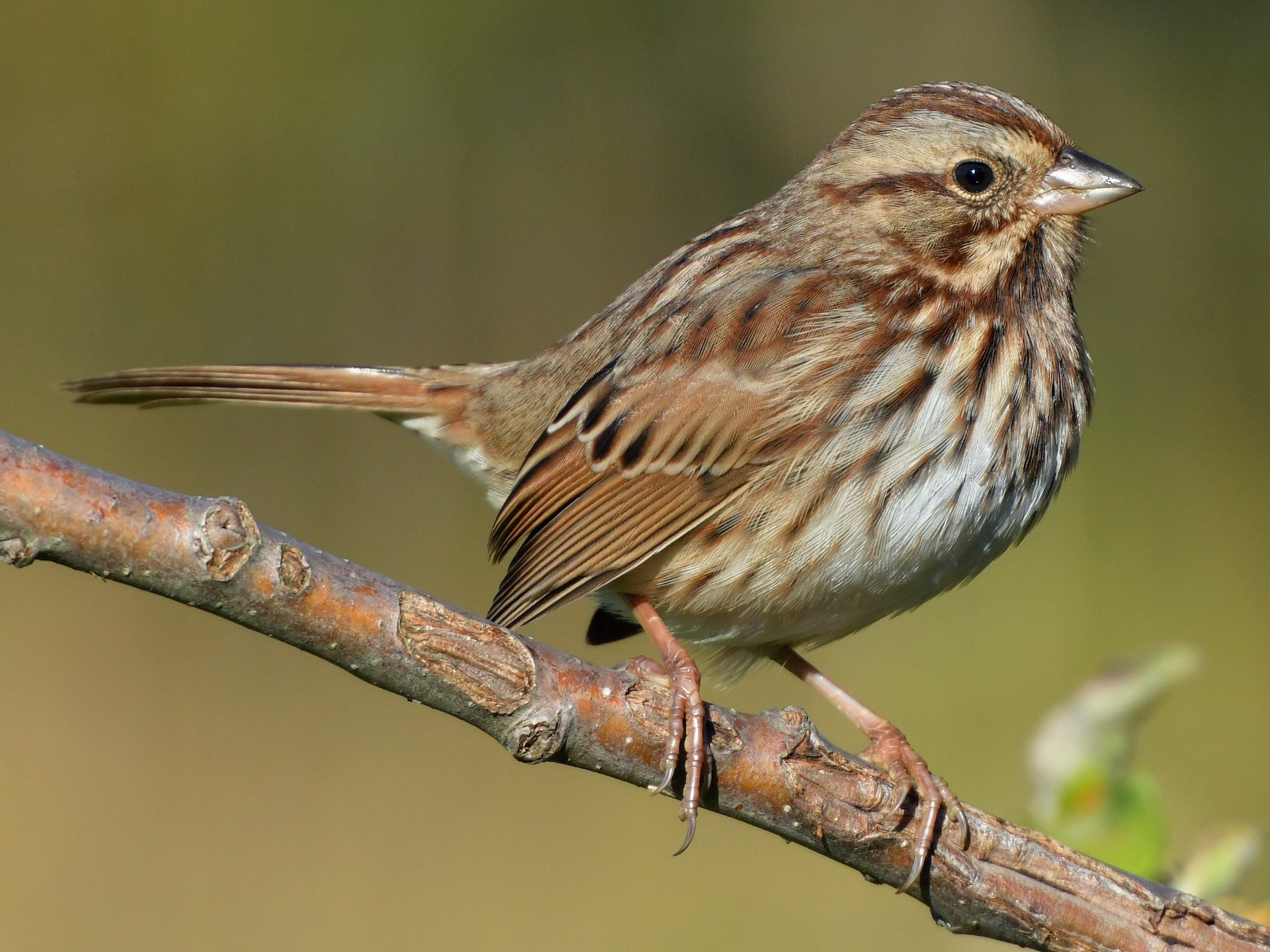
Song Sparrow, Melospiza melodia - A medium-sized sparrow with a streaked brown plumage and a melodious song, commonly found in wetland habitats.
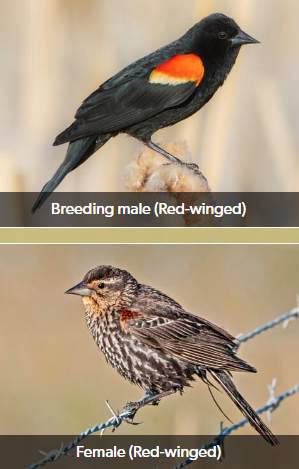
Red-winged Blackbird, Agelaius phoeniceus - A medium-sized blackbird with red and yellow shoulder patches, known for its distinctive "conk-la-ree" song, commonly found in marshes and wetlands.
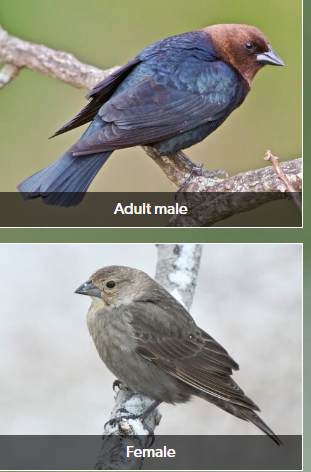
Brown-headed Cowbird, Molothrus ater - A medium-sized blackbird with a brown head and a habit of laying its eggs in the nests of other bird species. Live in grasslands.
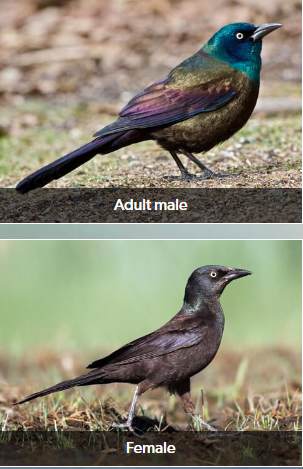
Common Grackle, Quiscalus quiscula - A large blackbird with iridescent feathers, yellow eyes, and a long tail. Known for its loud calls and aggressive behavior during breeding season. Live in open woodlands.
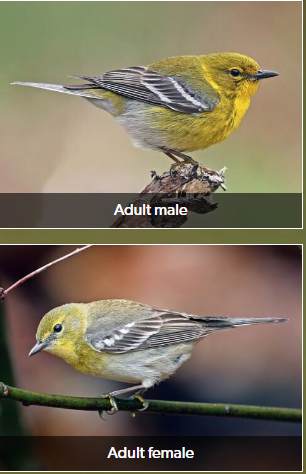
Pine Warbler, Setophaga pinus - A small songbird found in pine forests of eastern North America. Males are yellow with olive streaks, while females are duller. They primarily feed on insects and seeds. Live in forests.
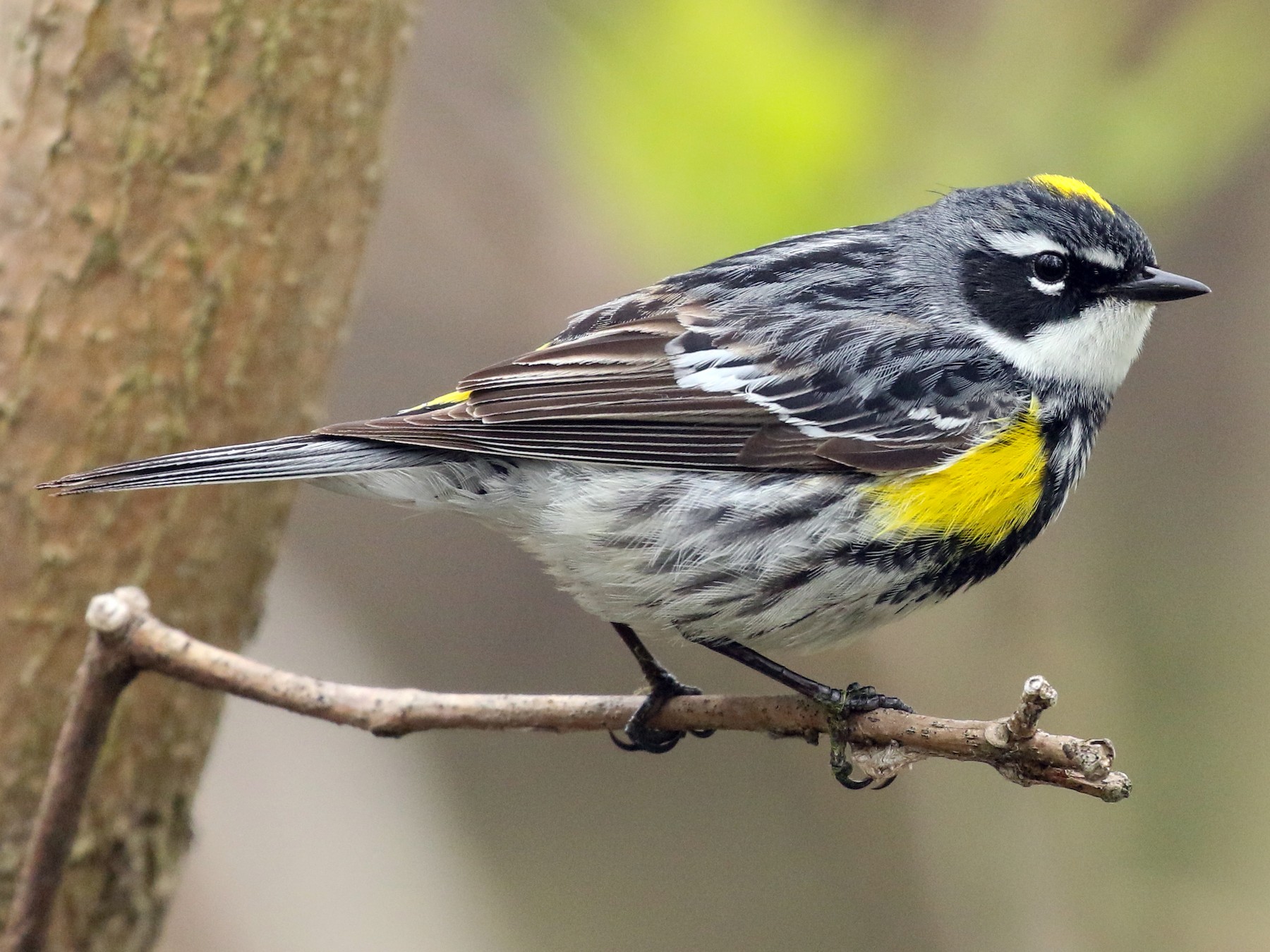
(Myrtle)
Yellow-rumped Warbler, Setophaga coronata - A small songbird with yellow patches on its rump and sides. It migrates long distances and can be found in various habitats across North America. In summer, both sexes are a smart gray with flashes of white in the wings and yellow on the face, sides, and rump. Males are very strikingly shaded; females are duller and may show some brown. Winter birds are paler brown, with bright yellow rump and usually some yellow on the sides.
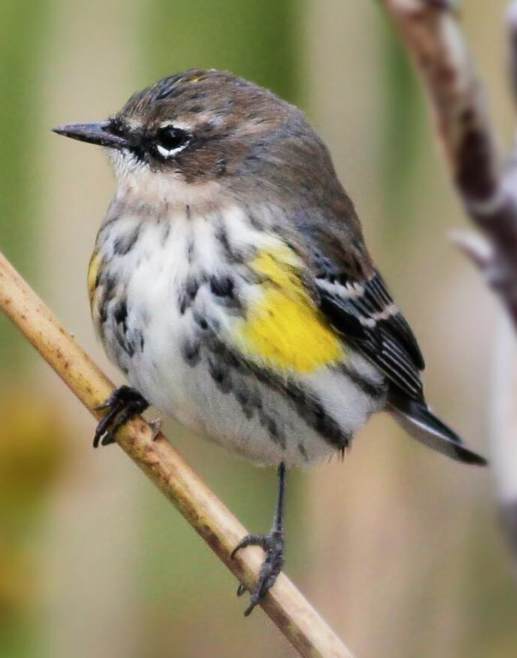
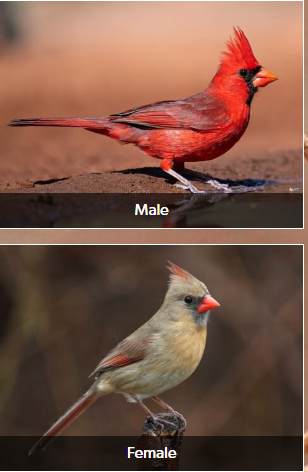
Northern Cardinal, Cardinalis cardinalis - Bright red bird with a crest, black mask, and strong beak. Females are tan with red accents. Known for their melodious songs. Live in open woodlands.

House Finch, Haemorhous mexicanus - Small songbird with a red forehead, throat, and breast. Males have brighter red coloration. Commonly found in North America. Feeds on seeds, fruits, and insects. Lives in Towns.
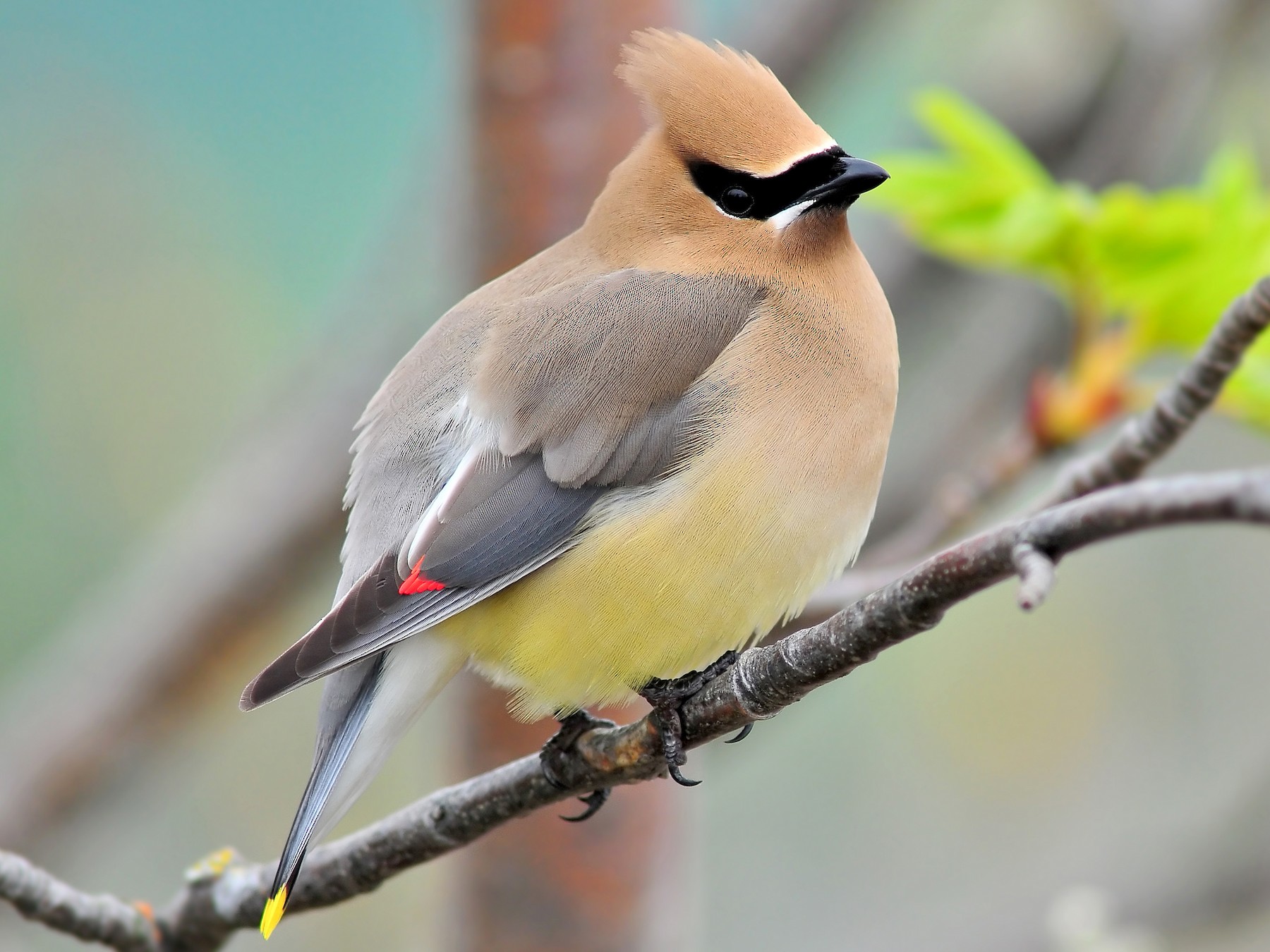
Cedar Waxwing, Bombycilla cedrorum - A sleek bird with a crest, yellow belly, and red wax-like tips on wing feathers. They are social and often travel in flocks to feed on fruit. Live in open woodlands.
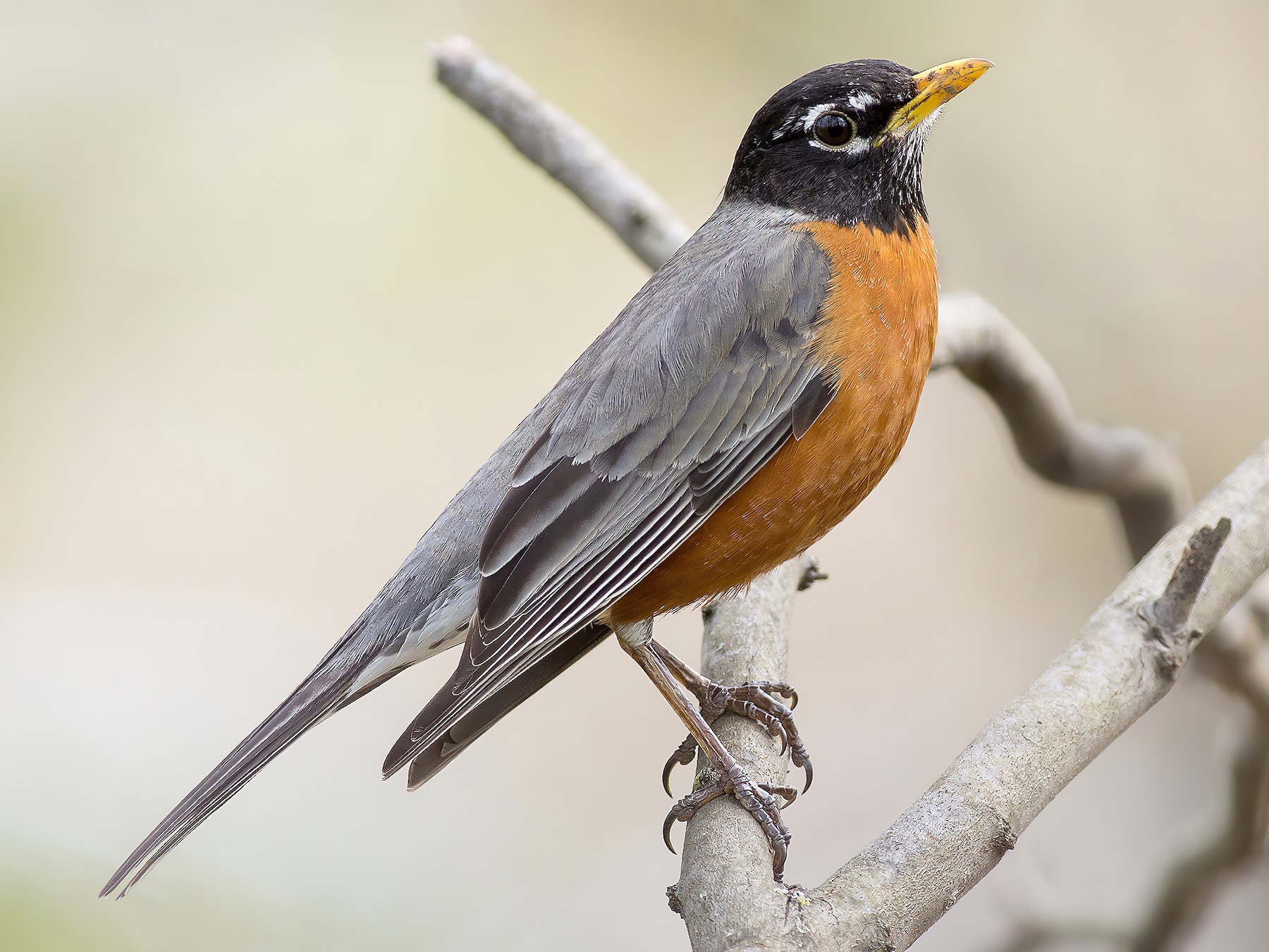
American Robin, Turdus migratorius - a migratory songbird found in North America. It has a red breast, gray upperparts, and a white eye ring. Robins are known for their melodious song and are commonly seen foraging for earthworms and insects in lawns and gardens (live in open woodlands).
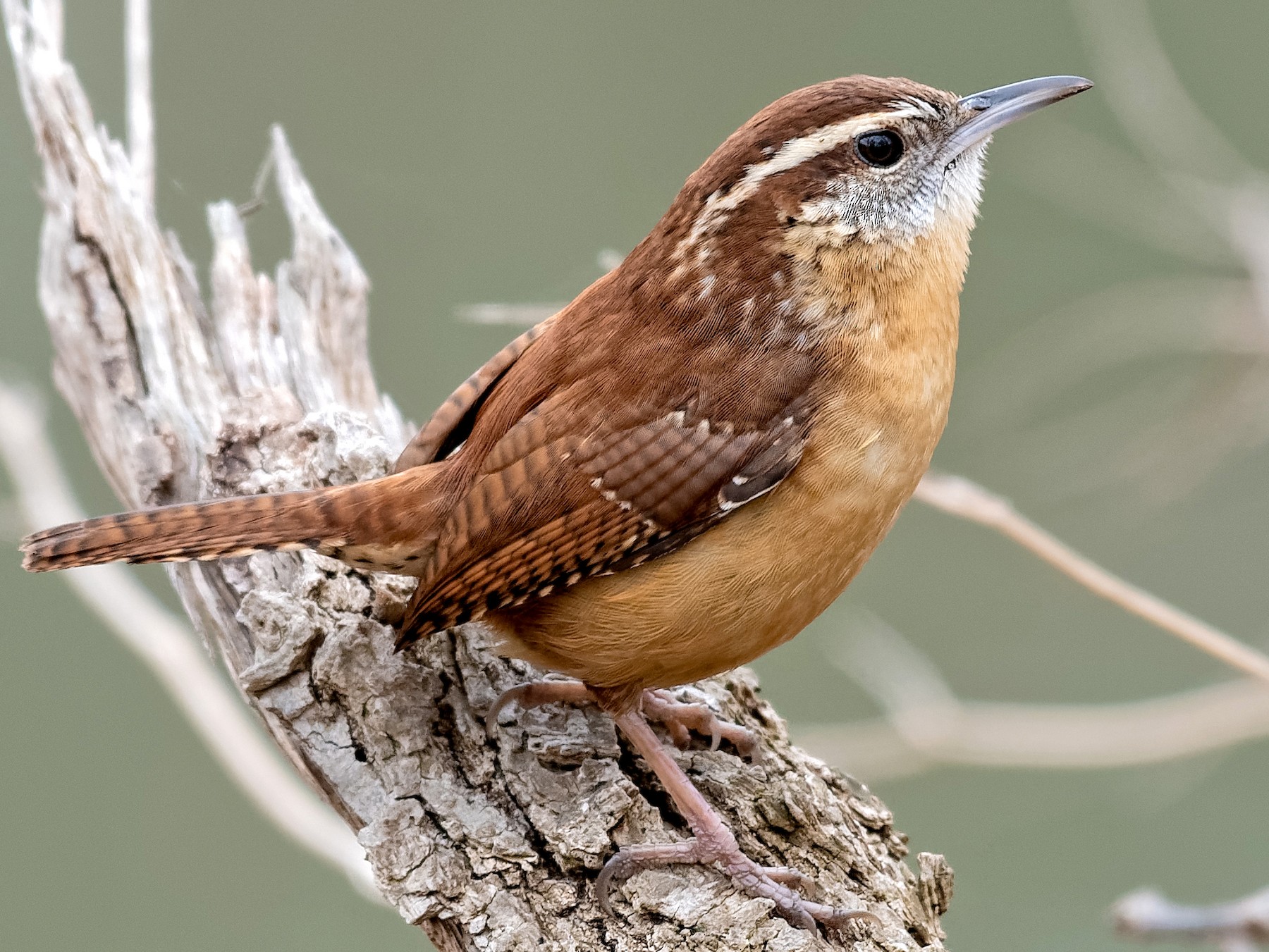
Carolina Wren, Thryothorus ludovicianus - a small bird with a reddish-brown back, white underparts, and a distinctive white eyebrow stripe. It has a loud, melodious song and is known for its bold behavior. Carolina Wrens are commonly found in wooded areas across the southeastern United States.
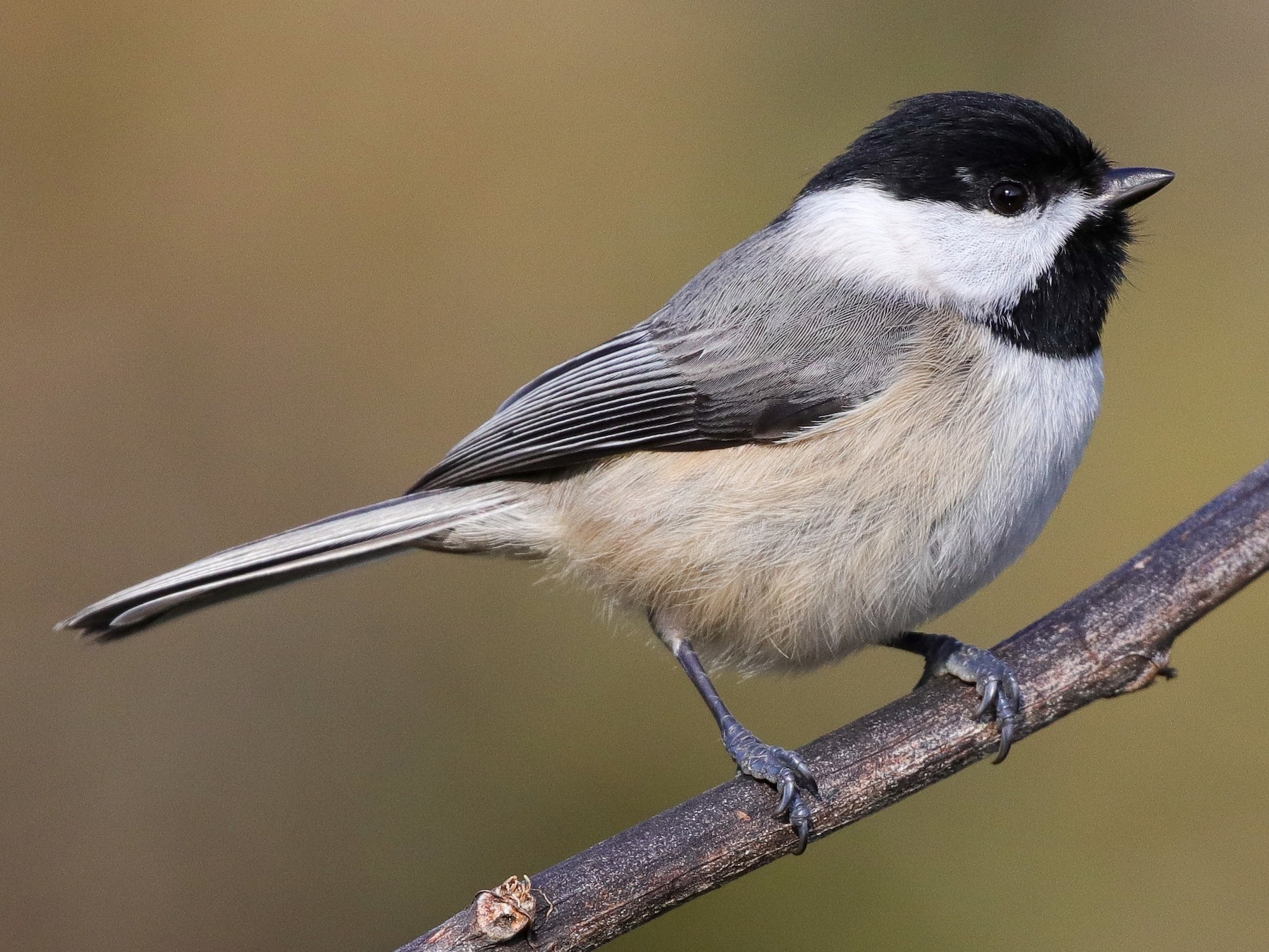
Carolina Chickadee, Poecile carolinensis - A small bird found in the southeastern United States, known for its black cap and bib, white cheeks, and distinctive "chick-a-dee-dee-dee" call. Live in forests.
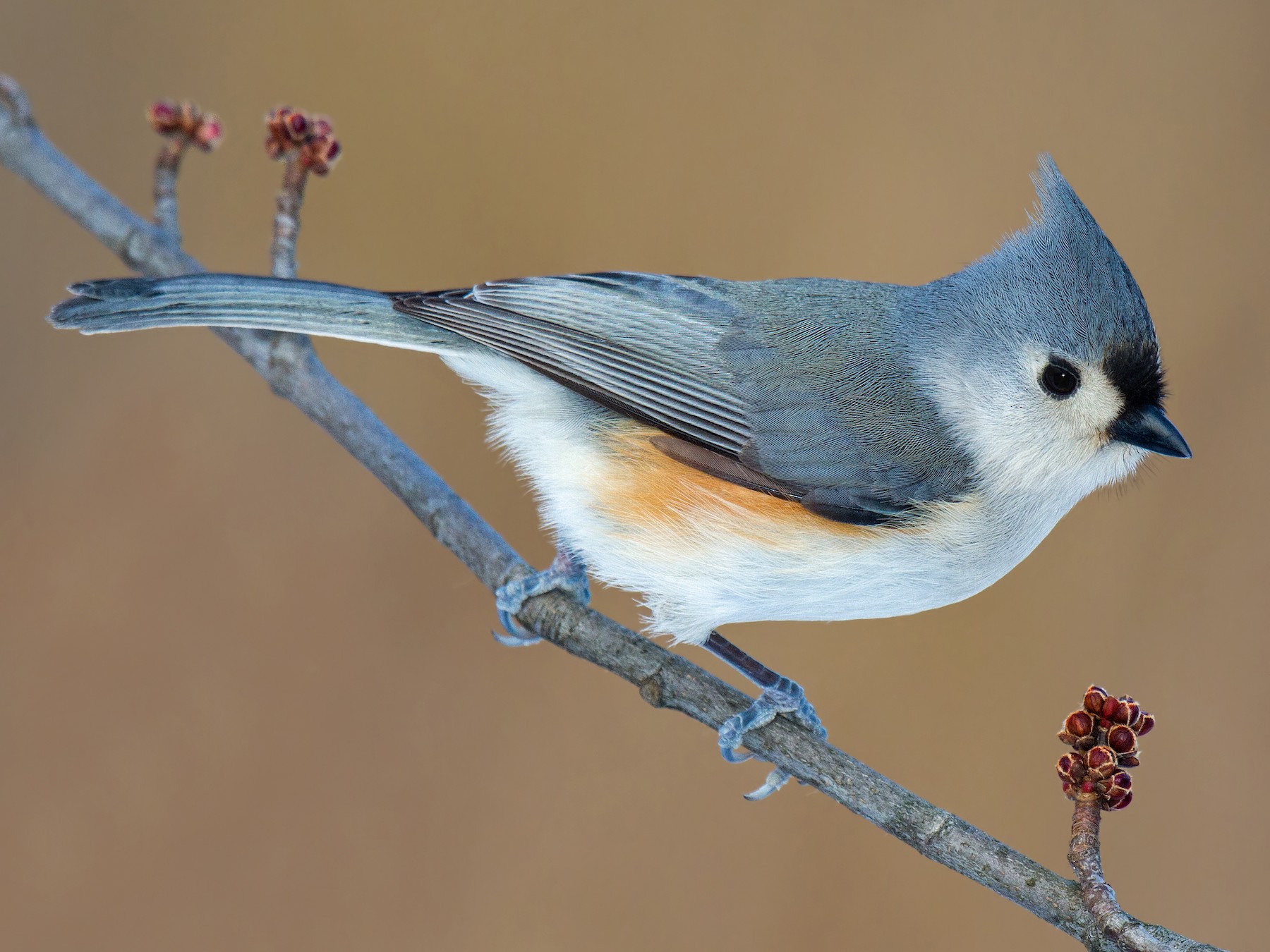
Tufted Titmouse, Baeolophus bicolor - a small songbird with a gray body, white underparts, and a distinctive crest on its head. It has a black patch just above its beak and is known for its loud, whistling "peter-peter-peter" call. Live in forests.
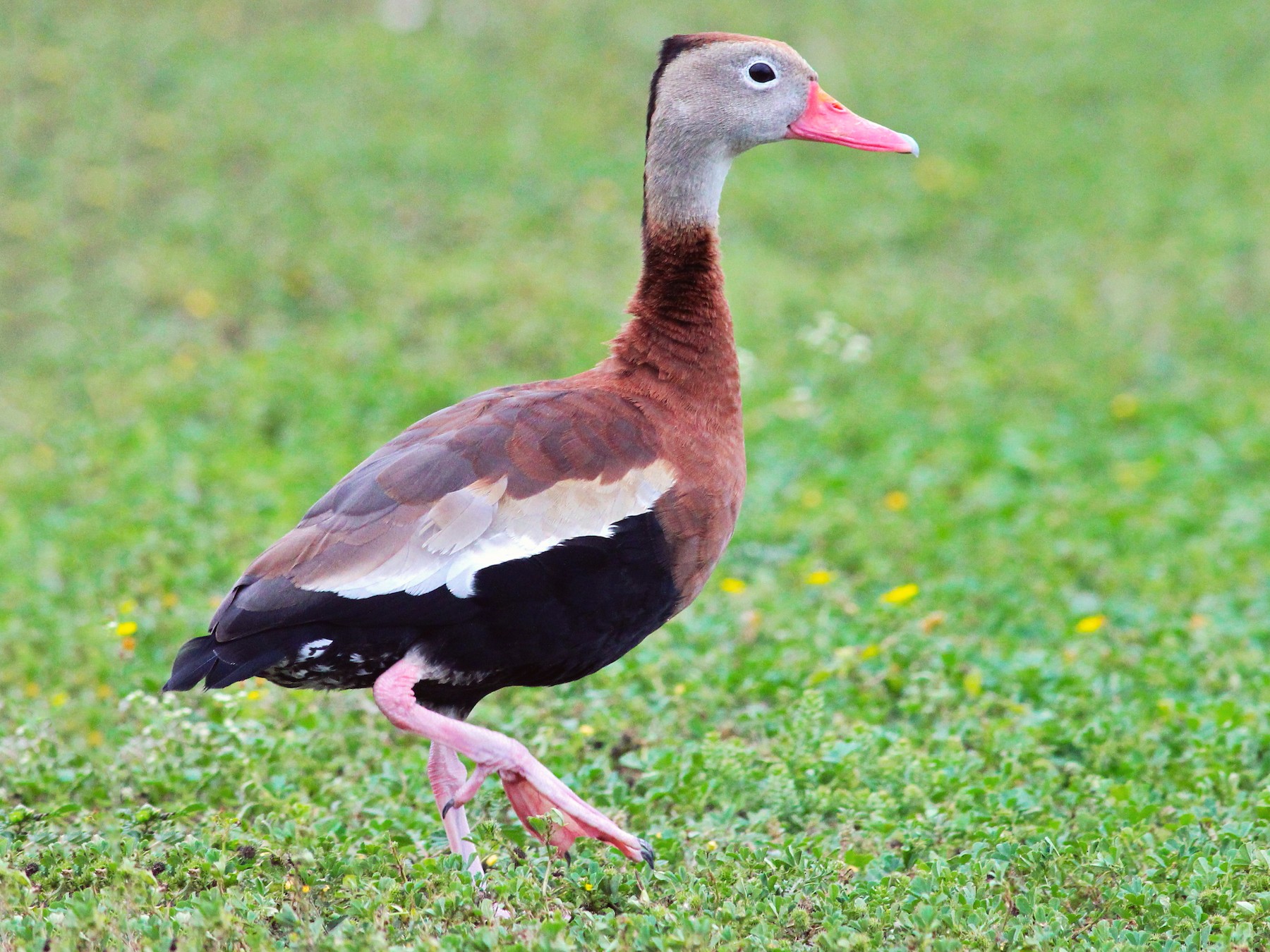
Black-bellied Whistling-Duck, Dendrocygna autumnalis - A species of duck known for its black belly and whistling call. Live in marshes.
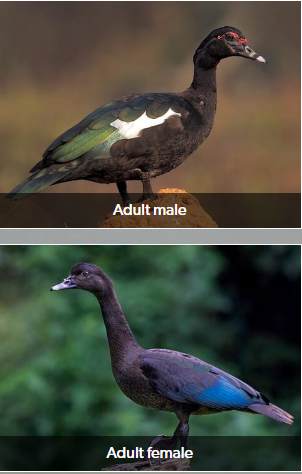
Muscovy Duck (Domestic type), Cairina moschata - A domesticated type of duck known for its large size and distinctive red facial skin. Females are less bright and colored. Live in forest.
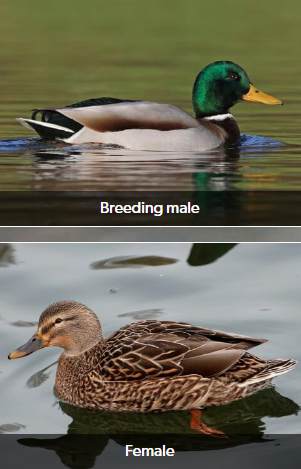
Mallard (Domestic type), Anas platyrhynchos (Domestic type) - A domesticated type of duck commonly found in parks and ponds, known for its colorful plumage. Sexually dimorphic. Live in Lakes and ponds.
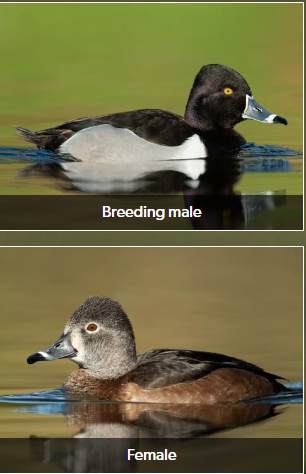
Ring-necked Duck, Aythya collaris - A species of diving duck with a distinctive white ring around its bill. Feeds of plants, and lives in lakes and ponds.
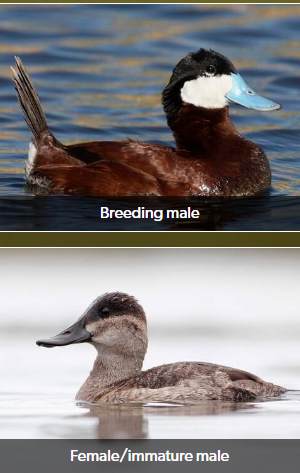
Ruddy Duck, Oxyura jamaicensis - A small diving duck with a blue bill and a reddish-brown body. (Blue billing is a breeding characteristic). Live in Marshes and feed on aquatic invertebrates.
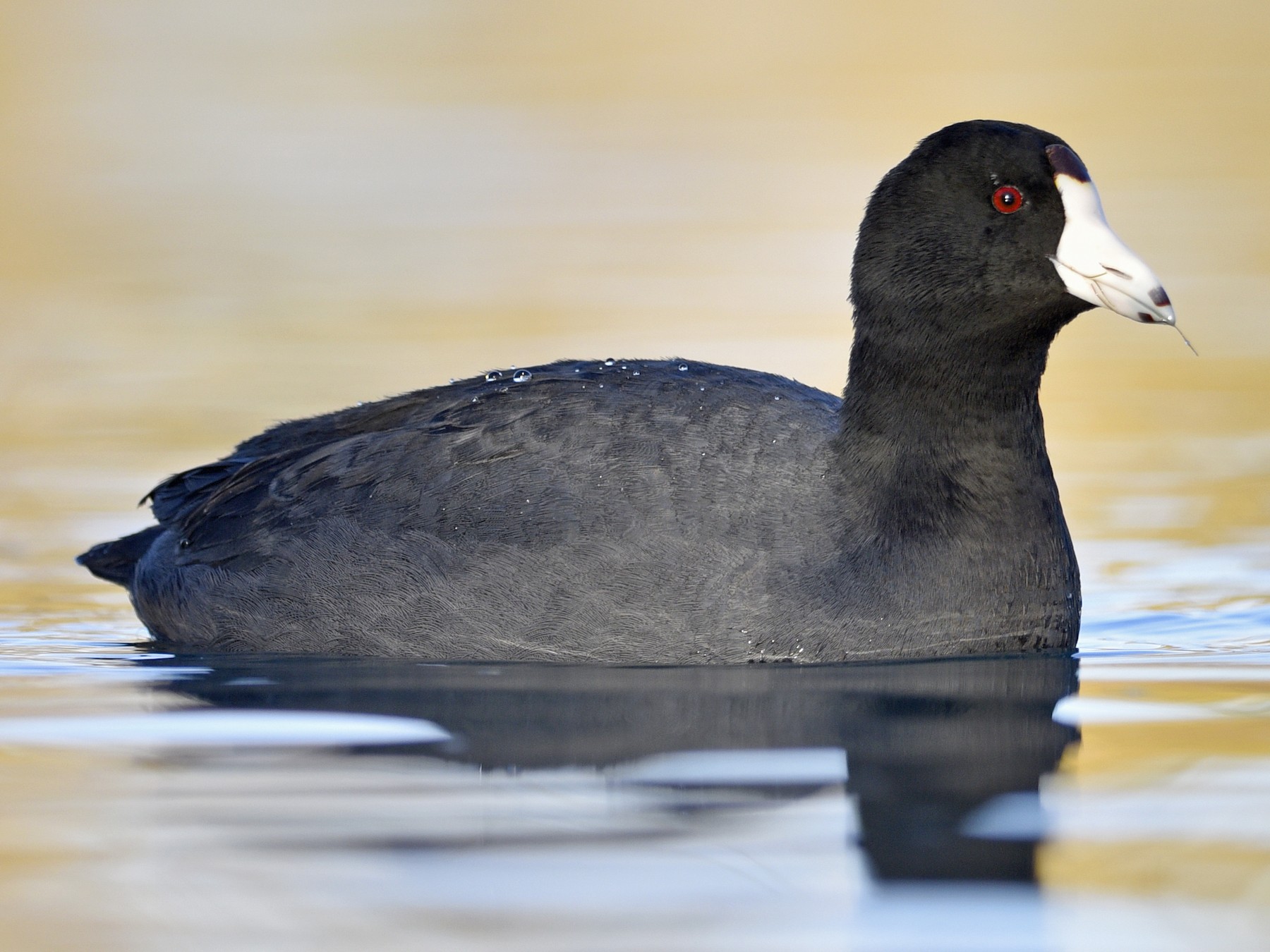
American Coot, Fulica americana - A bird species that resembles a small duck, known for its black body, white bill and red eyes. Live in lakes and ponds and feed on plants.
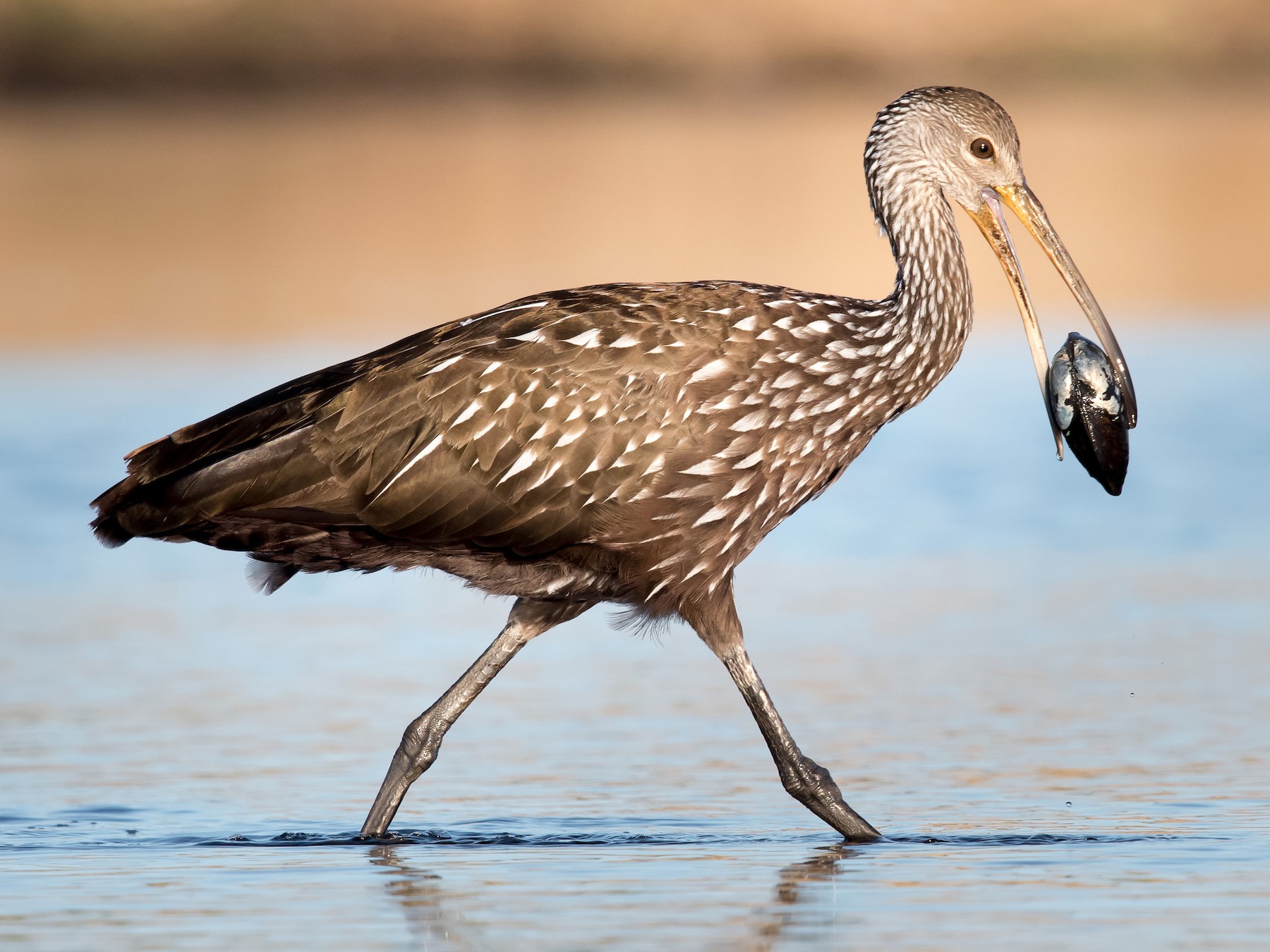
Limpkin, Aramus guarauna - A wading bird with a long neck and a loud, distinctive call. Live in Marshes and feed on aquatic invertebrates.
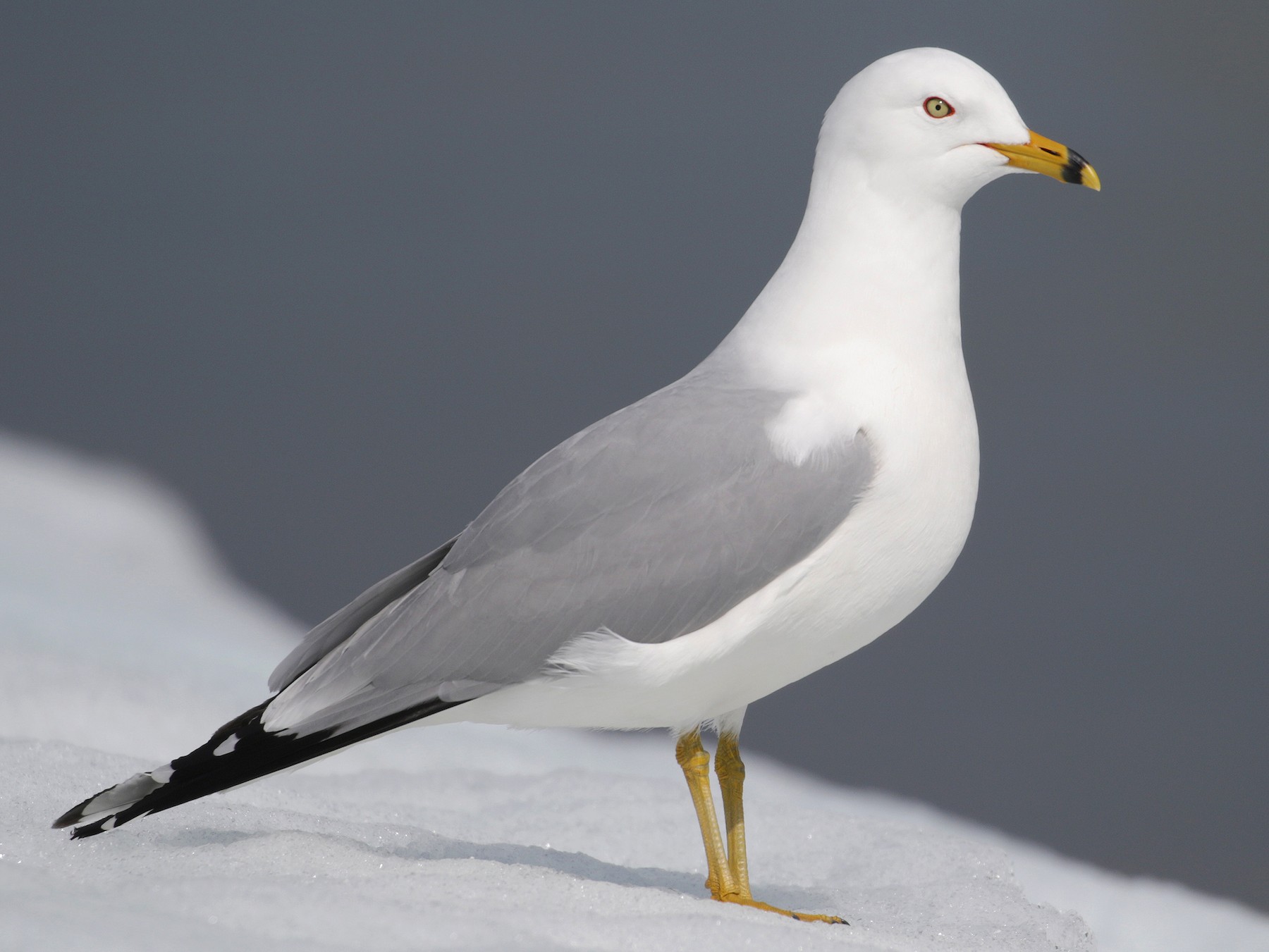
Ring-billed Gull, Larus delawarensis - A medium-sized gull with a white body, gray wings, and a black ring around its bill. Live in lakes and ponds and they are omnivores.
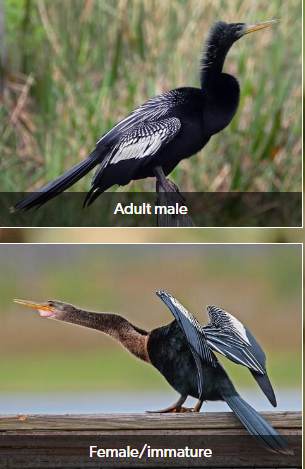
Anhinga, Anhinga anhinga - A water bird with a long neck and a spear-like bill, known for its ability to swim underwater. Lives in marshes and feeds on fish.
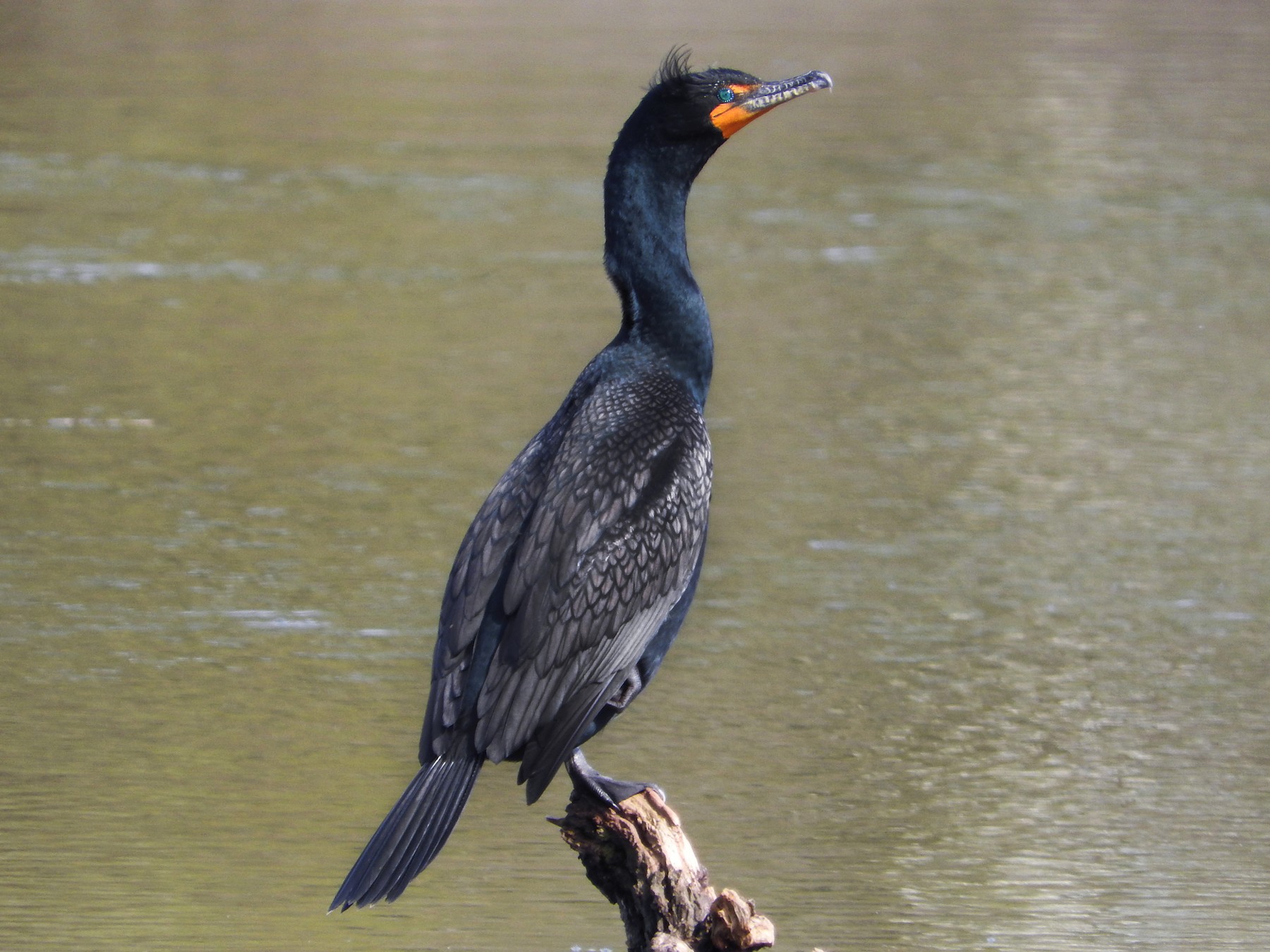
Double-crested Cormorant, Nannopterum auritum - A large water bird with dark plumage and a distinctive double crest on its head. Lives in lakes and ponds, feeds on fish.
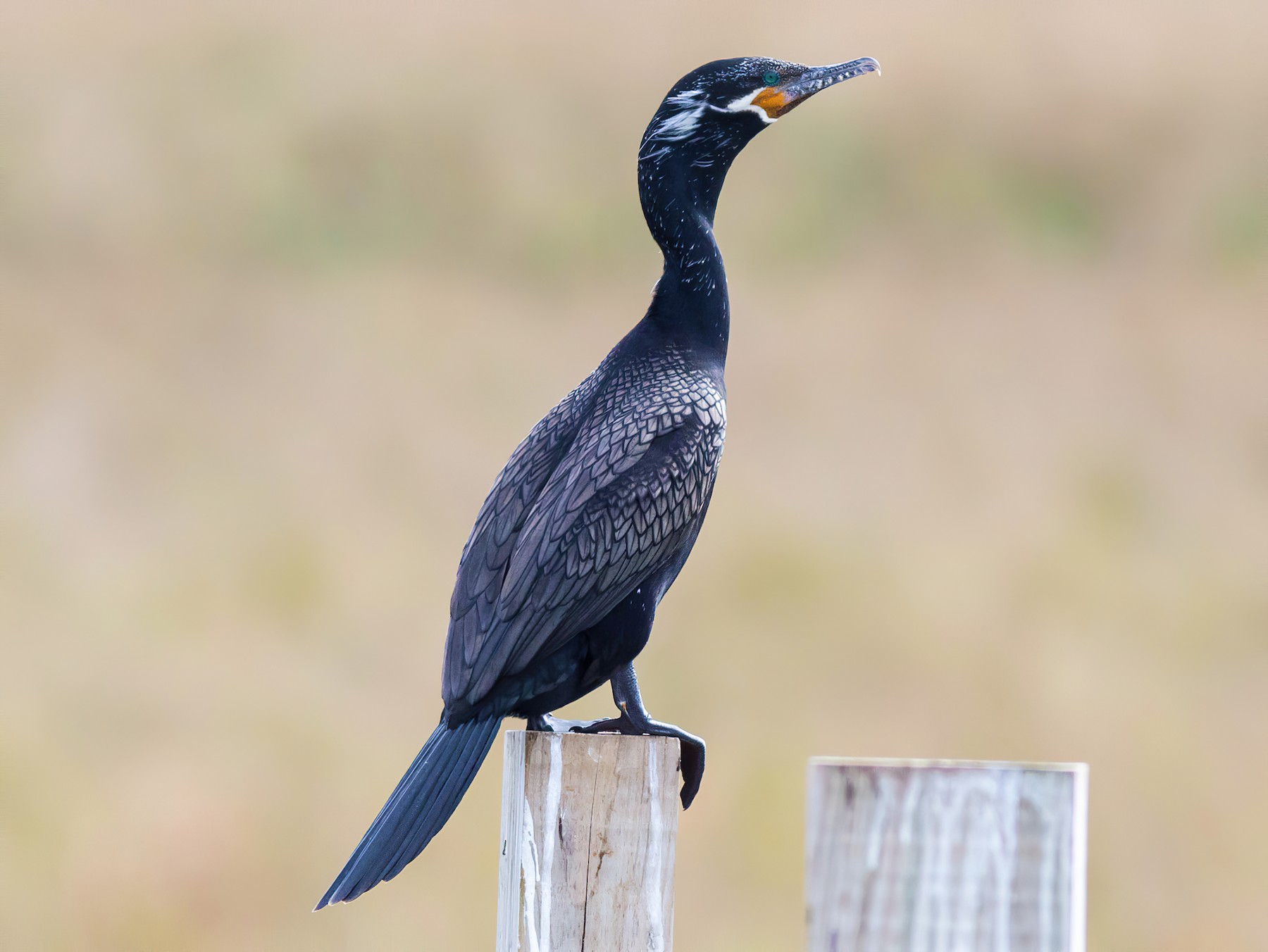
Neotropic Cormorant- Nannopterum brasilianum - A species of cormorant found in the Americas, known for its glossy black feathers. Lives in lakes and ponds and feeds on fish.
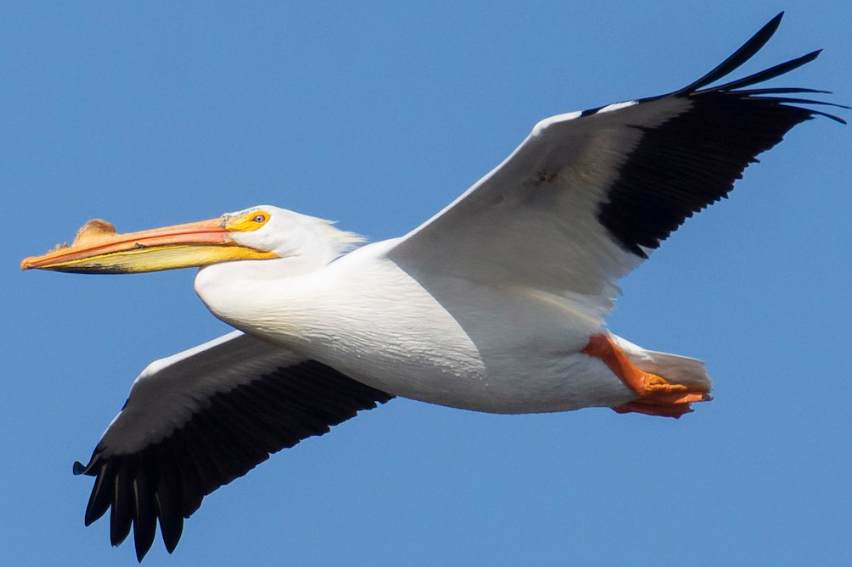
American White Pelican, Pelecanus erythrorhynchos - A large bird with a white body, a long bill, and a distinctive pouch under its throat. Live in lakes and ponds and feeds on fish.
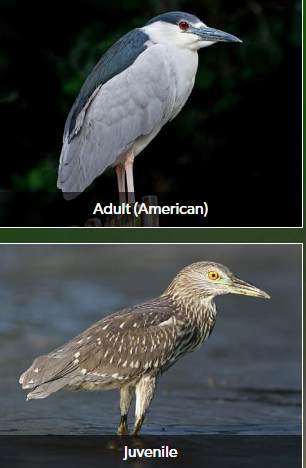
Black-crowned Night Heron, Nycticorax nycticorax - A medium-sized heron with a black crown and a gray body, commonly found near bodies of water. Lives in marshes and feeds on fish.
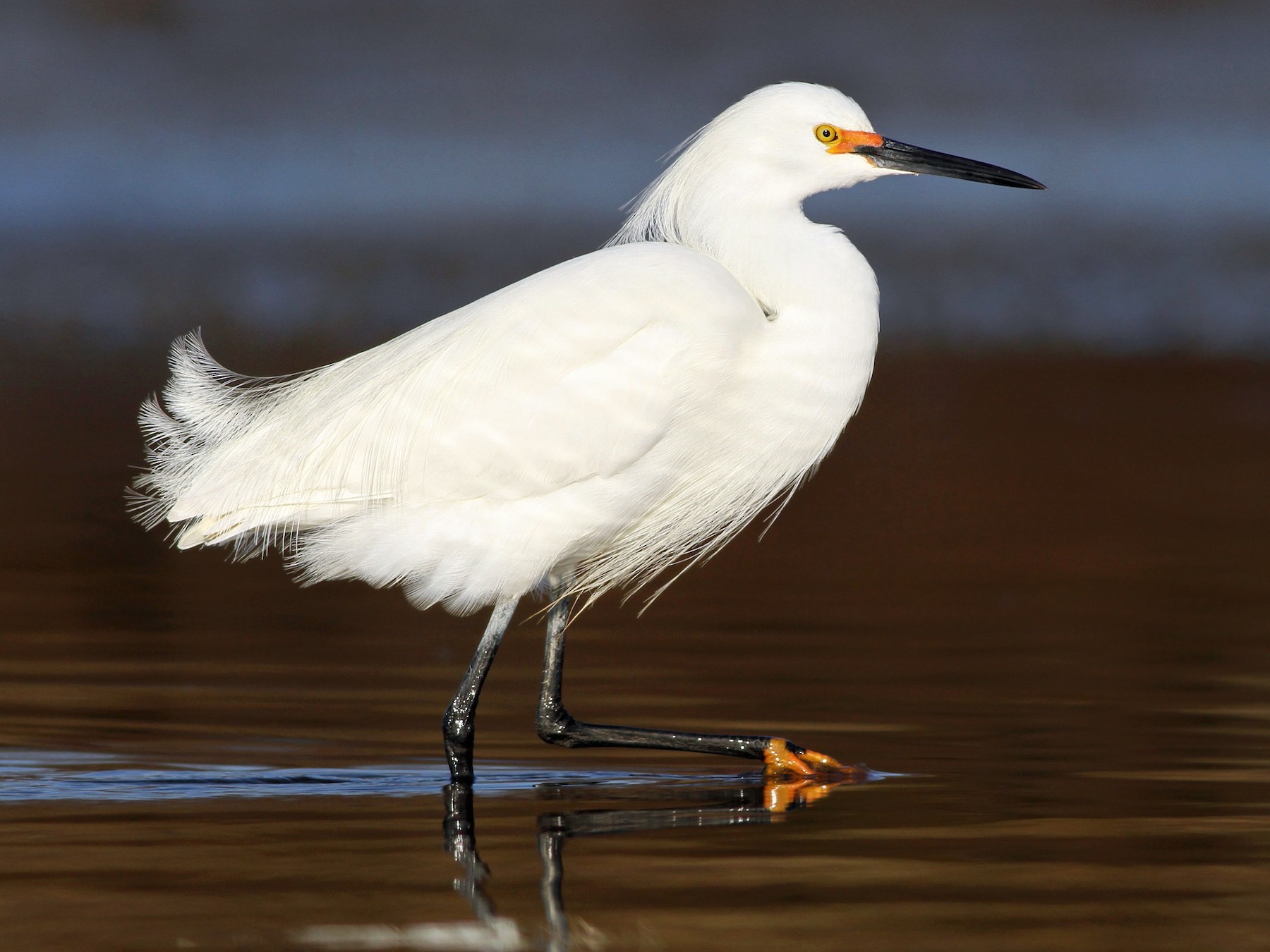
Snowy Egret, Egretta thula - A small white heron with a slender black bill and long black legs. It is known for its delicate plumage and yellow feet. Live in marshes and feed on fish.
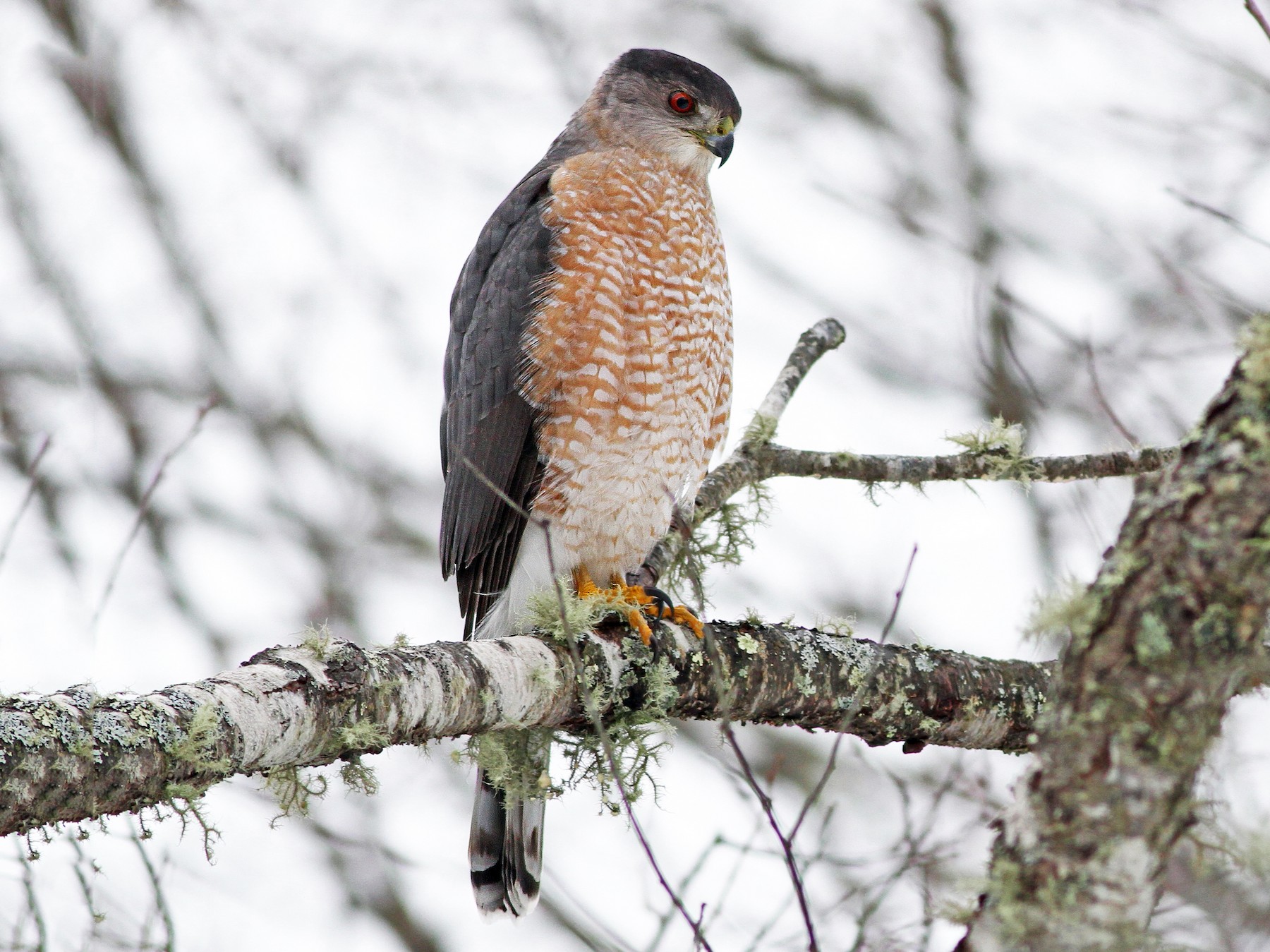
Cooper's Hawk, Accipiter cooperii - A medium-sized hawk with a dark back, a reddish-brown chest, and a long tail. Live in forest and feed on birds and other small mammals.
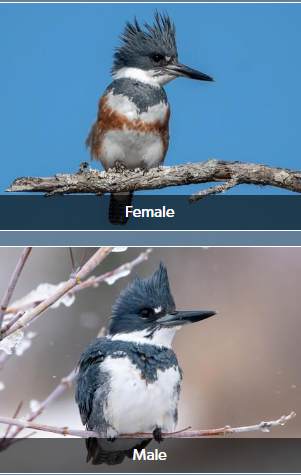
Belted Kingfisher, Megaceryle alcyon - A medium-sized bird with a blue-gray body, a shaggy crest, and a long, straight bill. Live in lakes and ponds and feed on fish.

Blue-headed Vireo, Vireo solitarius - A small songbird with a blue-gray head and a yellow body, known for its melodious song. Live in forests and feed on insects.
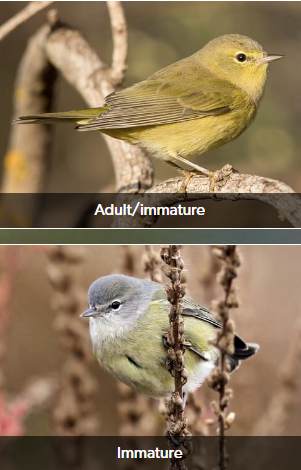
Orange-crowned Warbler, Leiothlypis celata - A small song bird with olive-green back, gray head, and faint orange patch on crown. Found in North America during breeding season. Lives in forests and feeds on insects.
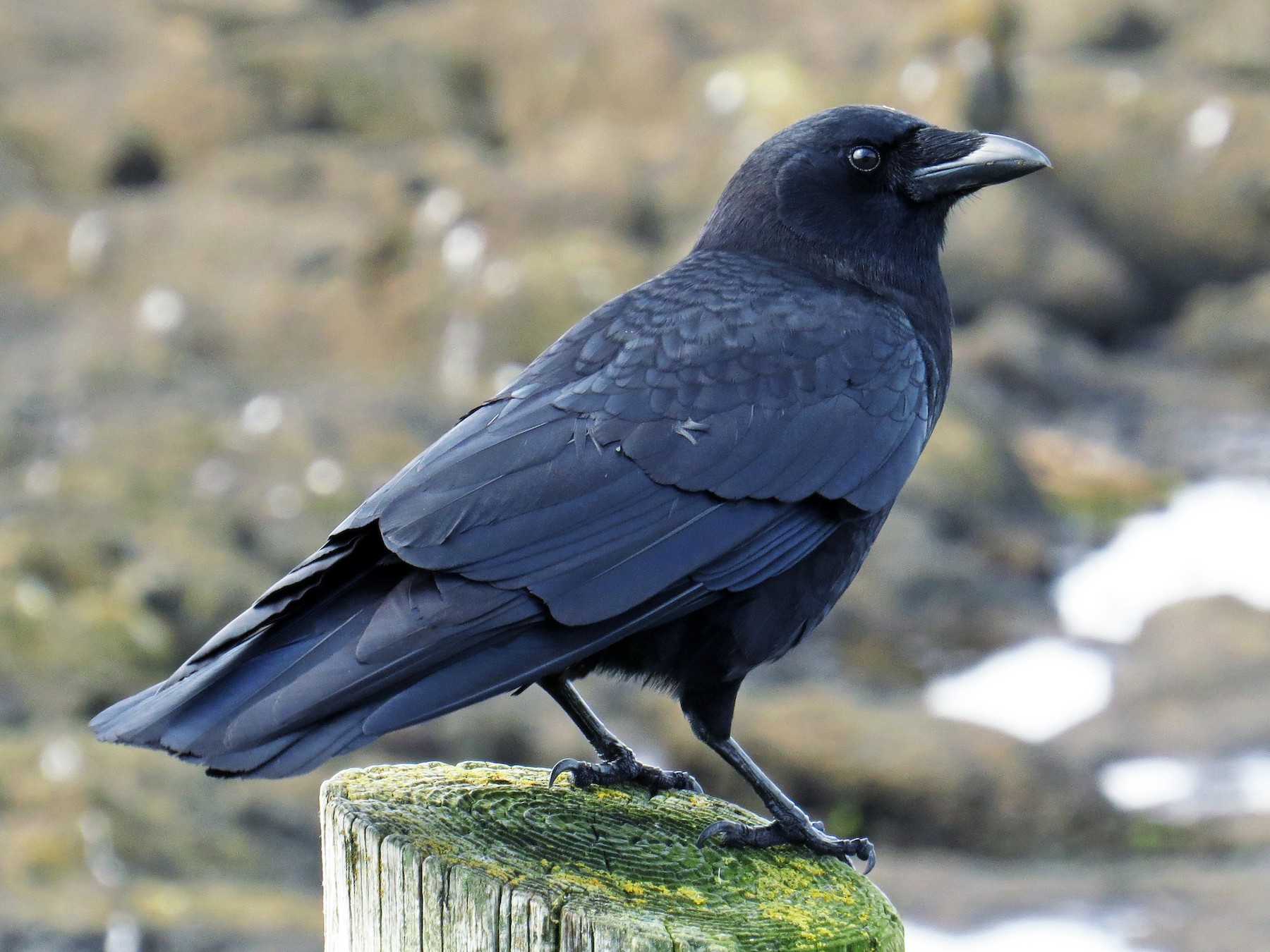
American Crow, Corvus brachyrhynchos - A large black bird known for its intelligence and adaptability, commonly found in urban and rural areas. Naturally live in open woodlands and are omnivores.
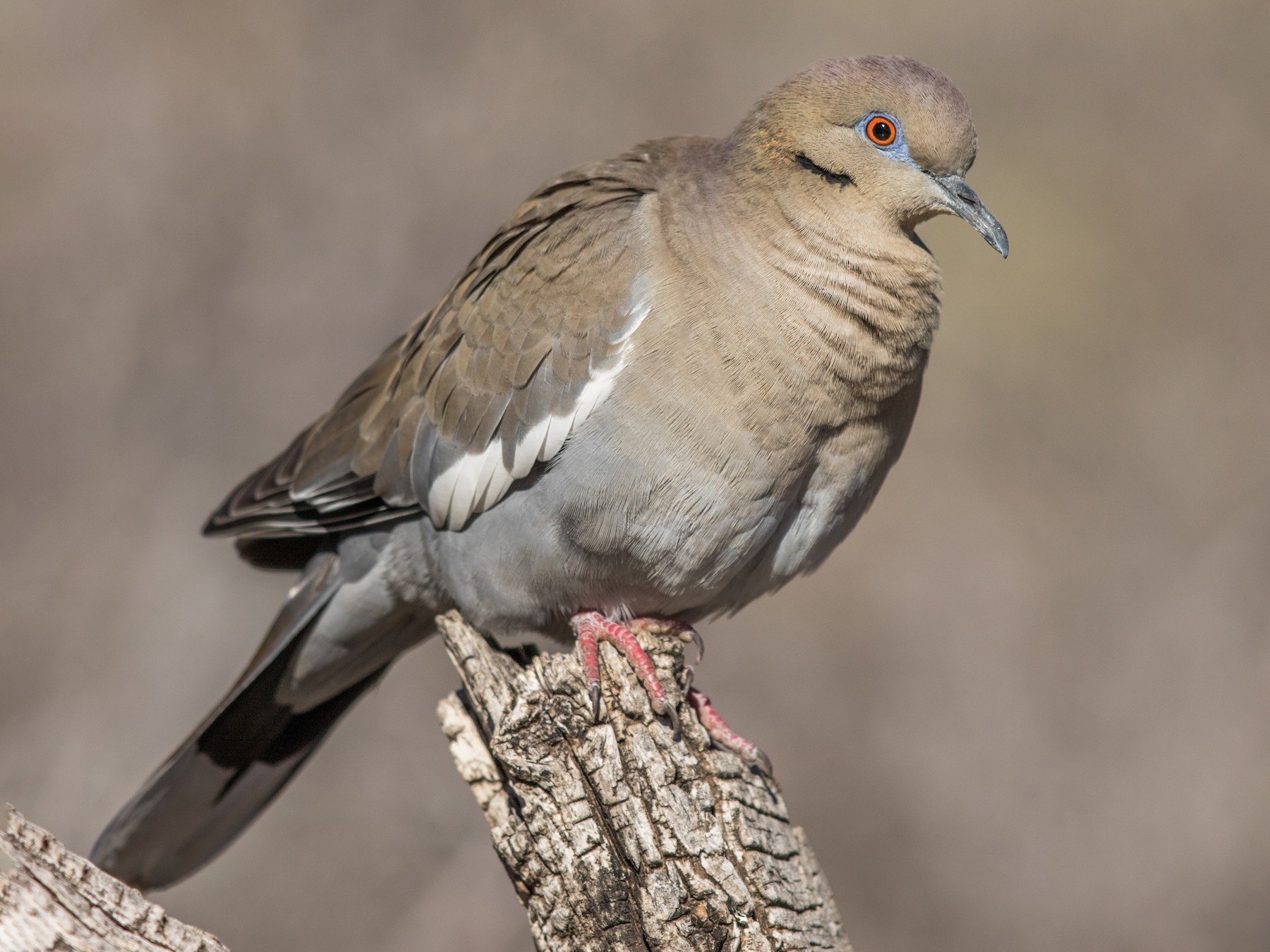
White-winged Dove, Zenaida asiatica - A medium-sized dove with white wing patches visible in flight. Found in the southern United States and Mexico. Known for its distinctive cooing call. Live in open woodlands and feed on seeds.
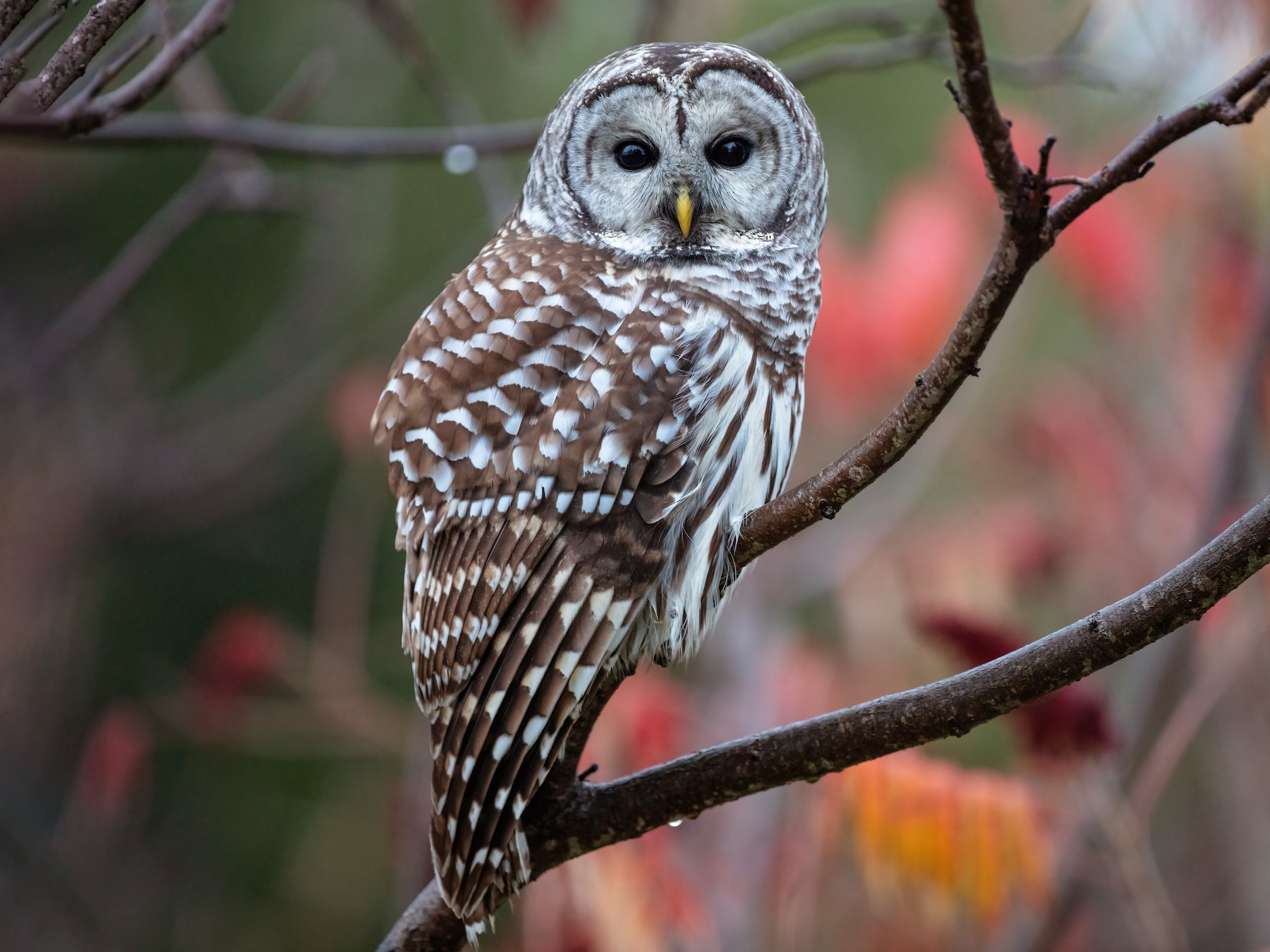
Barred Owl, Strix varia - Large owl with brown and white bars on its body. Known for its distinctive "Who cooks for you?" call. Adapted to various habitats but live in forests and feed on mammals.
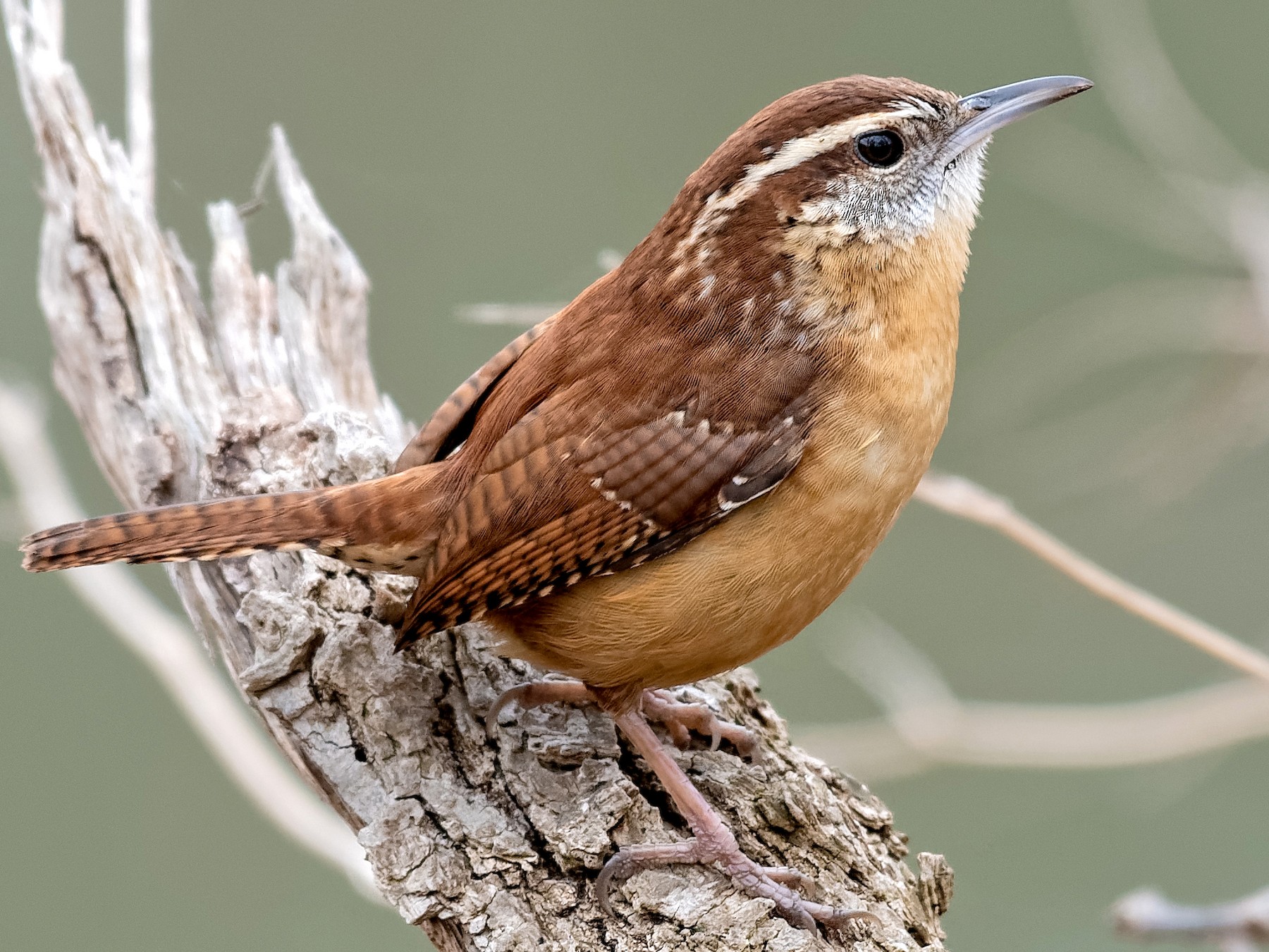
Carolina Wren, Thryothorus ludovicianus - A small bird with a distinctive white eyebrow, reddish-brown back, and a loud, melodious song. Found in the eastern United States.
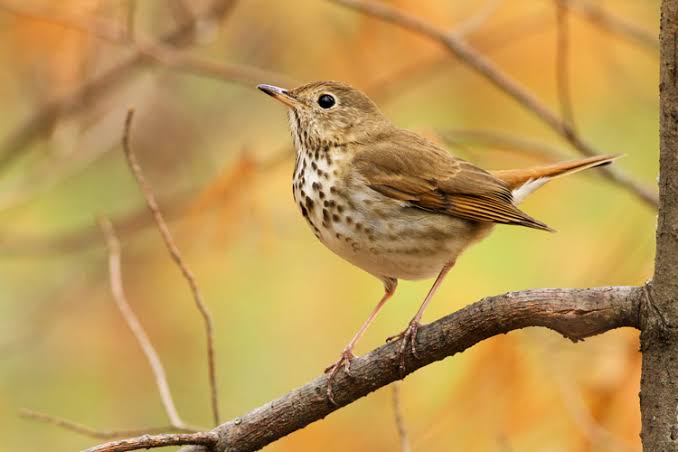
Hermit Thrush, Catharus guttatus - Small North American bird with a reddish tail that sings a flute-like song in forests. Lives in open woodlands and feeds on insects.
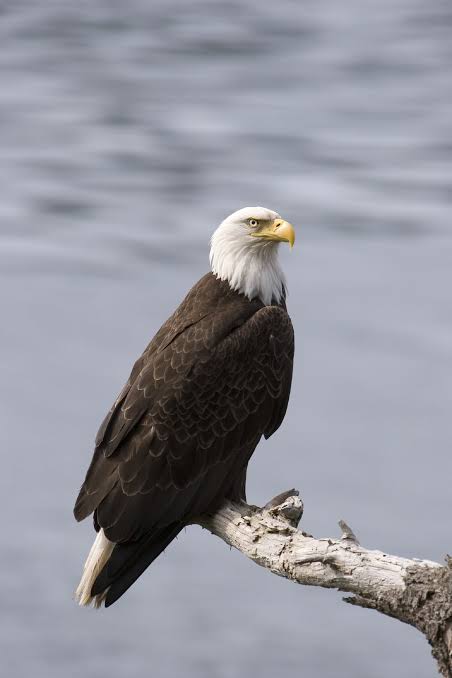
Bald Eagle, Haliaeetus leucocephalus - The plumage of an adult bald eagle is evenly dark brown with a white head and tail. The tail is moderately long and slightly wedge-shaped. Males and females are identical in plumage coloration, but sexual dimorphism is evident in the species, in that females are 25% larger than males. The beak, feet and irises are bright yellow. The legs are feather-free, and the toes are short and powerful with large talons.
It is the only sea eagle endemic to North America. Occupying varied habitats from the bayous of Louisiana to the Sonoran Desert and the eastern deciduous forests of Quebec and New England, northern birds are migratory, while southern birds are resident, remaining on their breeding territory all year.
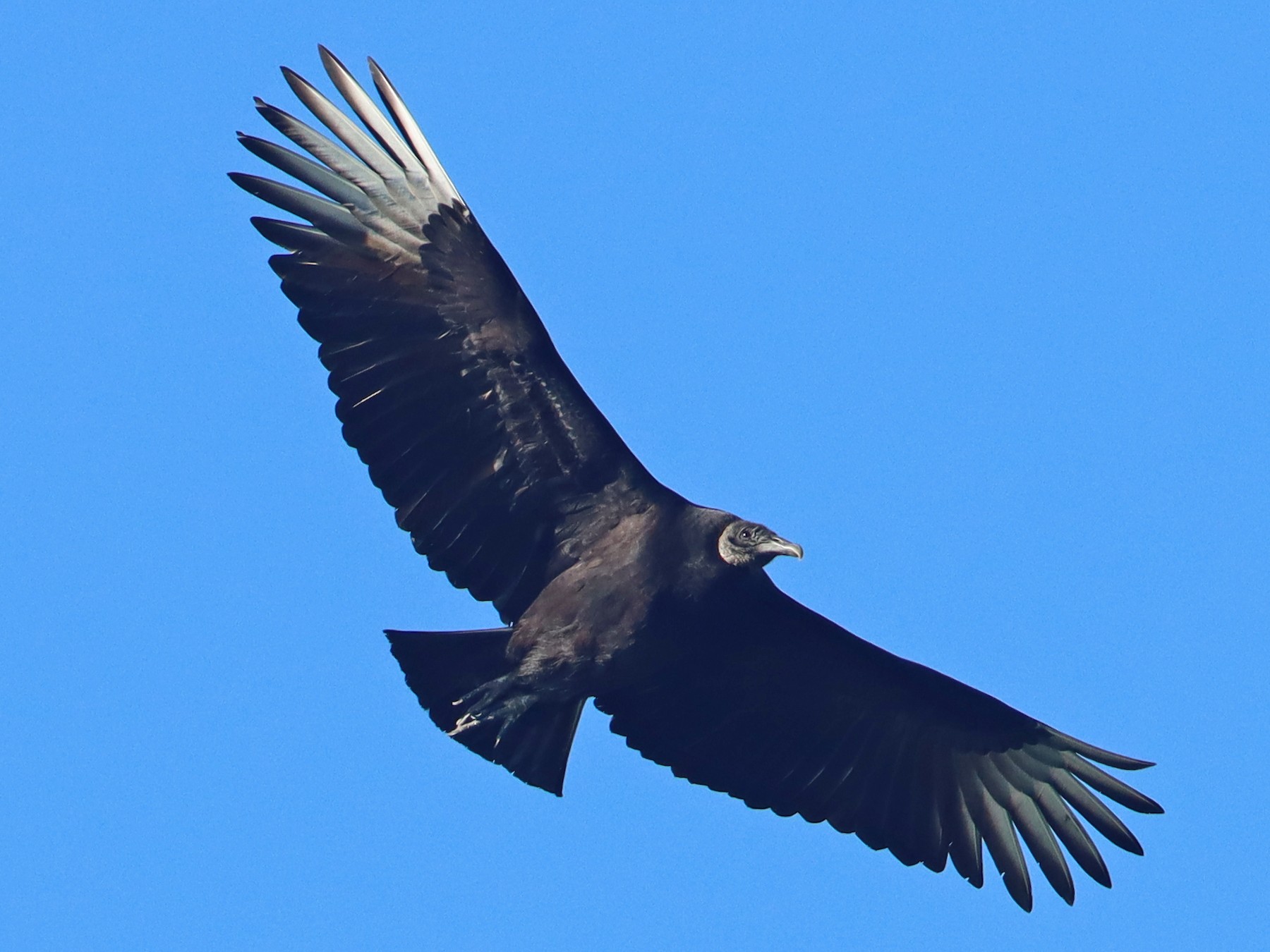
Black Vulture, Coragyps atratus - These birds are uniform black except for white patches or “stars” on the underside of their wingtips (this can be hard to see in strong light or from far away). The bare skin of the head is black. Look for Black Vultures in open areas within forested landscapes.
They typically nest and roost in wooded areas and soar above open areas to seek their food.
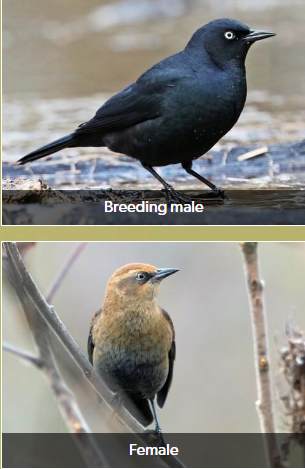
Rusty Blackbird, Euphagus carolinus - In winter, male Rusty Blackbirds are recognized by their rusty feather edges, pale yellow eye and buffy eyebrow. Females are gray-brown; they also have rusty feather edges, pale eyes and a bold eyebrow, contrasting with darker feathers right around the eye. Breeding males are dark glossy black.
Look for Rusty Blackbirds in wet areas, including flooded woods, swamps, marshes and the edges of ponds. These moist habitats are their favorite foraging areas in winter and during migration. During the breeding season, they favor bogs, beaver ponds and wet woods in boreal forest.
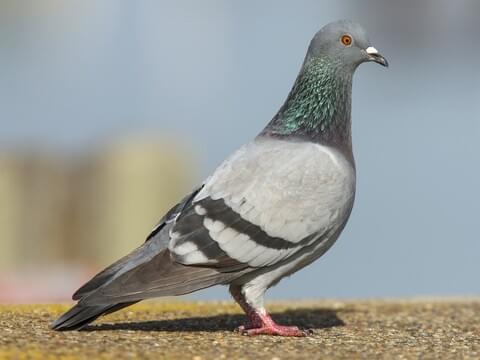
Rock Pigeon, Columba livia (Feral Pigeon) - They’re fucking Rock Pigeons dude c’mon. Pigeons are familiar birds of cities and towns. You'll also see them around farmland and fields, as well as in their archetypal habitat, rocky cliffs. They feed on seeds.
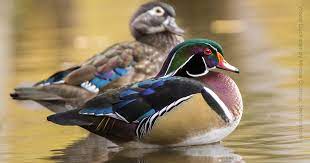
(Female in back, Male in front)
Wood Duck, Aix sponsa - Wood Ducks have a unique shape among ducks—a boxy, crested head, a thin neck, and a long, broad tail. In flight, they hold their head up high, sometimes bobbing it. Overall, their silhouette shows a skinny neck, long body, thick tail, and short wings. Look for Wood Ducks in wooded swamps, marshes, streams, beaver ponds, and small lakes. They stick to wet areas with trees or extensive cattails. As a cavity nester, Wood Ducks take readily to nest boxes.
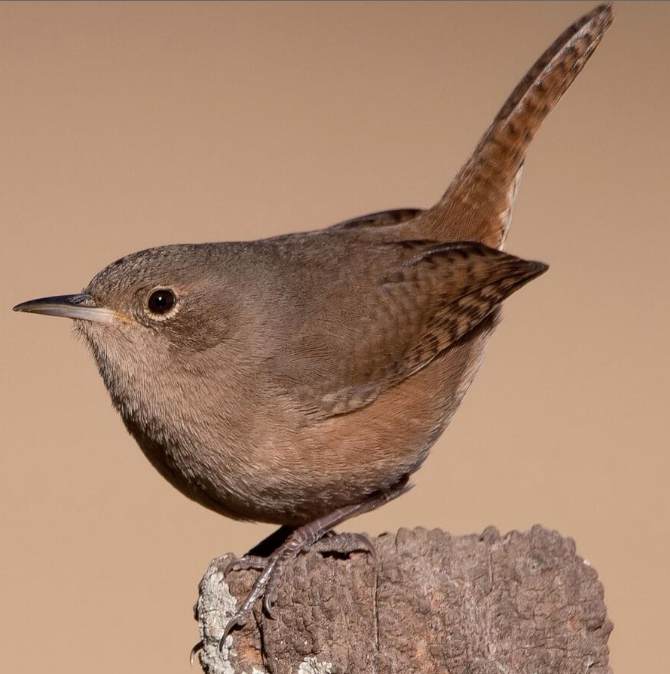
House Wren, Troglodytes aedon - House Wrens have a huge geographic range, and they live in many habitats, so long as they feature trees, shrubs, and tangles interspersed with clearings. Examples range from eastern deciduous forests and southern swamps to western conifer forests and aspen groves as high as 10,000 feet elevation. They feed on insects.
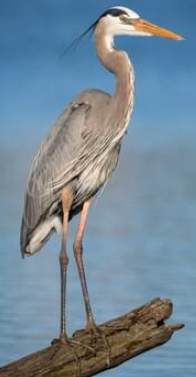
Great Blue Heron, Ardea herodias - Great Blue Herons appear blue-gray from a distance, with a wide black stripe over the eye. In flight, the upper side of the wing is two-toned: pale on the forewing and darker on the flight feathers. A pure white subspecies occurs in coastal southern Florida.
Look for Great Blue Herons in saltwater and freshwater habitats, from open coasts, marshes, sloughs, riverbanks, and lakes to backyard goldfish ponds. They also forage in grasslands and agricultural fields. Breeding birds gather in colonies or “heronries” to build stick nests high off the ground.
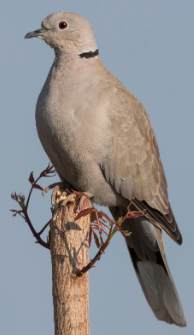
Eurasian Collared-Dove, Streptopelia decaocto - Eurasian Collared-Doves are chalky light brown to gray-buff birds with broad white patches in the tail. The bird’s collar is a narrow black crescent around the nape of the neck. In flight and when perched, the wingtips are darker than the rest of the wing.
Eurasian Collared-Doves live in urban and suburban areas throughout much of the U.S. except the Northeast. In rural settings look for them on farms and in livestock yards where grain is available.
Feeds on seeds.
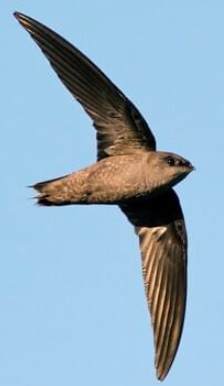
Chimney Swift, Chaetura pelagica - Chimney Swifts are very small birds with slender bodies and very long, narrow, curved wings. They have round heads, short necks, and short, tapered tails. The wide bill is so short that it is hard to see. They are dark gray-brown all over, slightly paler on the throat. At distance and when backlit against they sky they can appear to be all black.
Chimney Swifts nest in chimneys and on other vertical surfaces in dim, enclosed areas, including air vents, wells, hollow trees, and caves. They forage over urban and suburban areas, rivers, lakes, forests, and fields. They feed on insects.
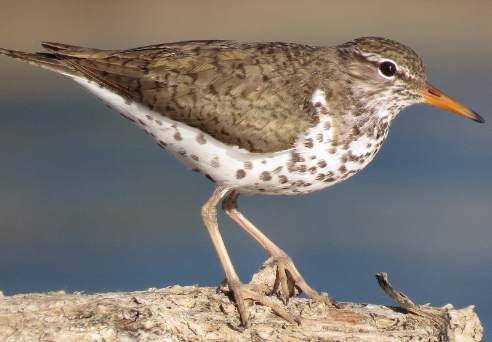
Spotted Sandpiper, Actitis macularius - The Spotted Sandpiper is a medium-sized shorebird with a bill slightly shorter than its head and a body that tapers to a longish tail. They have a rounded breast and usually appear as though they are leaning forward. (Breeding Spotted Sandpipers have bold dark spots on their bright white breast and an orange bill)
Look for Spotted Sandpipers nearly anywhere near water—along streambanks, rivers, ponds, lakes, and beaches, particularly on rocky shores. This species is one of the most widespread breeding shorebirds in the United States and is commonly seen near freshwater, even in otherwise arid or forested regions.
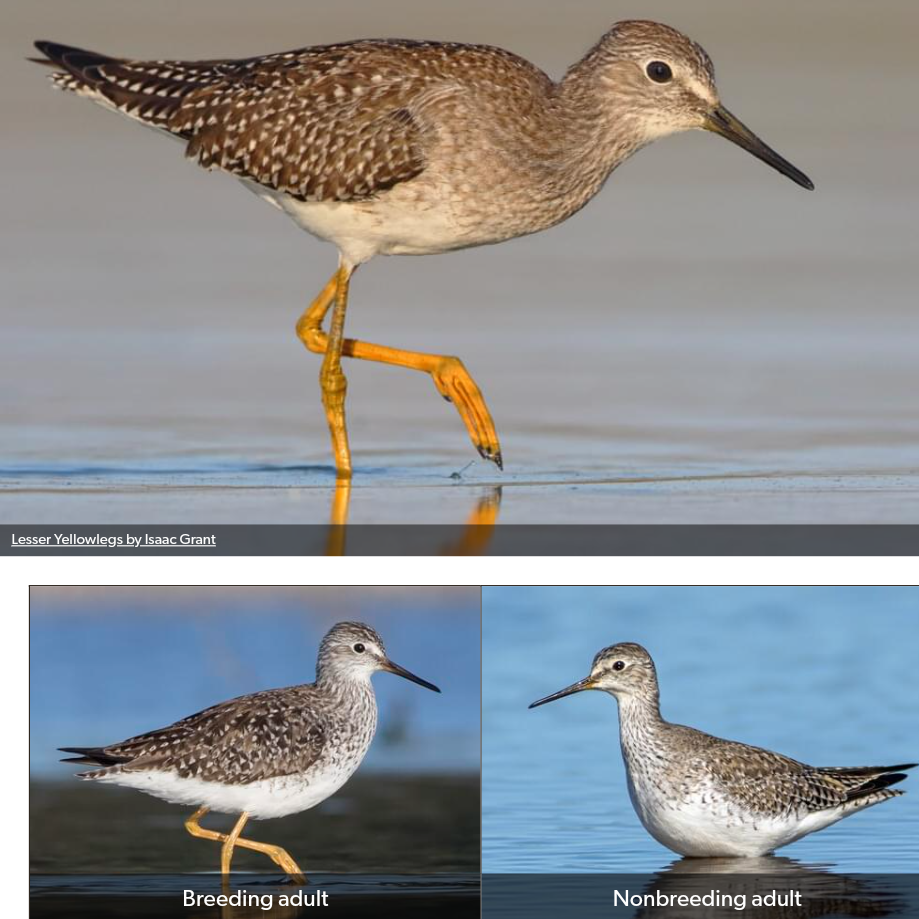
Lesser Yellowlegs, Tringa flavipes - Breeding Lesser Yellowlegs are grayish brown birds with vivid yellow legs. They have fine, gray streaking across the head and neck, a white eyering, and white spots on the back and wings. Nonbreeding birds are more subdued gray-brown with less streaking and spotting. Bill is entirely dark.
A slender and elegant, medium-sized shorebirds with long legs and a long neck. The bill is straight and thin, only slightly longer than the bird's head.
Wetland habitats ranging from tidal flats to sewage ponds to flooded fields; often in the company of other shorebird species. Breeds in open forests and meadows interspersed with marshes and bogs.
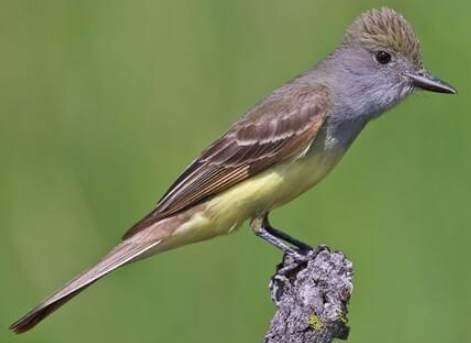
Great Crested Flycatcher, Myiarchus crinitus - Great Crested Flycatchers are reddish-brown above, with a brownish-gray head, gray throat and breast, and bright lemon-yellow belly. The brown upperparts are highlighted by rufous-orange flashes in the primaries and in the tail feathers. The black bill sometimes shows a bit of pale color at the base.
Great Crested Flycatchers live in woodlots and open woodland, particularly among deciduous trees. On its tropical wintering grounds it occurs in similar semiopen habitats. Migrants can occur in nearly any wooded or shrubby habitat. They feed on insects.

Eastern Kingbird, Tyrannus tyrannus - Eastern Kingbirds are blackish above and white below. The head is a darker black than the wings and back, and the black tail has a conspicuous white tip.
Eastern Kingbirds breed in open habitats such as yards, fields, pastures, grasslands, or wetlands, and are especially abundant in open places along forest edges or water. They spend winters in forests of South America. They feed on insects.
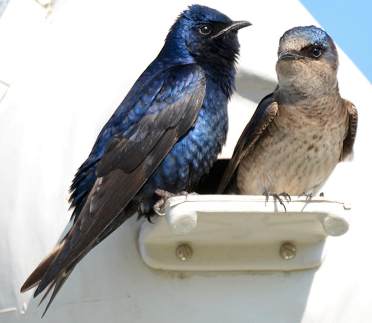
Purple Martin, Progne subis - Purple Martins are very large, broad-chested swallows. They have stout, slightly hooked bills, short, forked tails, and long, tapered wings. Adult males are iridescent, dark blue-purple overall with brown-black wings and tail. Females and immatures are duller, with variable amounts of gray on the head and chest and a whitish lower belly.
Purple Martins are colonial, with dozens of martins nesting in the same spot; they feed in open areas, especially near water. In the East they nest almost exclusively in nest boxes and martin houses; in the West you’ll find them nesting in natural cavities. They feed on insects.

Orchard Oriole, Icterus spurius - Adult males are black above and rich reddish-chestnut below. They have a black head and throat, with a reddish-chestnut patch at the bend of the wing. Females are greenish yellow with two white wing bars and no black. Immature males look like females, but have black around the bill and throat.
Orchard Orioles spend summers in open woodlands and areas of scattered trees across the eastern United States and southern Canada. Look for them along river edges, in pastures with scattered trees, and in parks and orchards. They feed on insects.
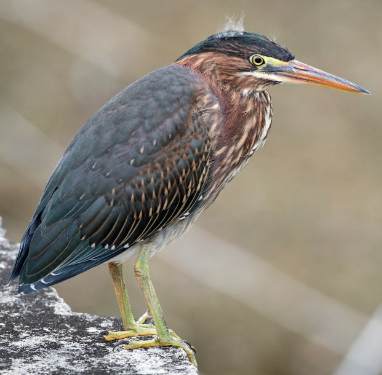
Green Heron, Butorides virescens - From a distance Green Herons look all dark. In better light they are deep green on the back with a rich chestnut breast and neck. The wings are dark gray. Juveniles are browner, with pale streaking on the neck and spots on the wings.
Green Herons live around wooded ponds, marshes, rivers, reservoirs, and estuaries. They feed on fish.
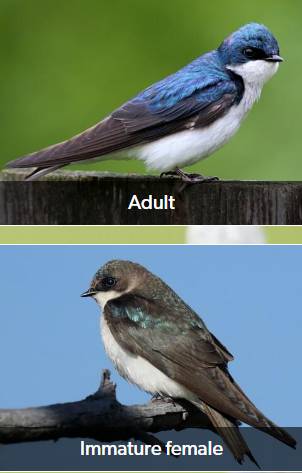
Tree Swallow, Tachycineta bicolor - Adult males are blue-green above and white below with blackish flight feathers and a thin black eye mask; females are duller with more brown in their upperparts, and juveniles are completely brown above. Juveniles and some females can show a weak, blurry gray-brown breast band.
Tree Swallows breed in open habitats such as fields and wetlands, usually adjacent to water. They nest in artificial nest boxes as well as tree cavities. Foraging flocks are frequently seen over wetlands, water, and agricultural fields.
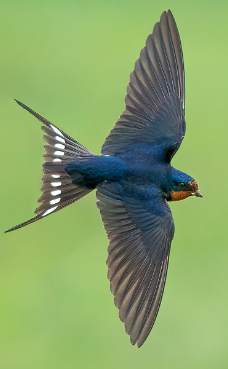
Barn Swallow, Hirundo rustica - When perched, the sparrow-sized Barn Swallow appears cone shaped, with a slightly flattened head, no visible neck, and broad shoulders that taper to long, pointed wings. The tail extends well beyond the wingtips and the long outer feathers give the tail a deep fork.
Barn Swallows have a steely blue back, wings, and tail, and rufous to tawny underparts. The blue crown and face contrast with the cinnamon-colored forehead and throat. White spots under the tail can be difficult to see except in flight. Males are more boldly colored than females. They feed on insects.
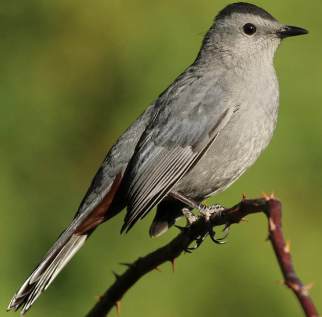
Gray Catbird, Dumetella carolinensis - A medium-sized, slender songbird with a long, rounded, black tail and a narrow, straight bill. Catbirds are fairly long legged and have broad, rounded wings.
Catbirds give the impression of being entirely slaty gray. With a closer look you’ll see a small black cap, blackish tail, and a rich rufous-brown patch under the tail.
Look for Gray Catbirds in dense tangles of shrubs, small trees, and vines, along forest edges, streamside thickets, old fields, and fencerows.
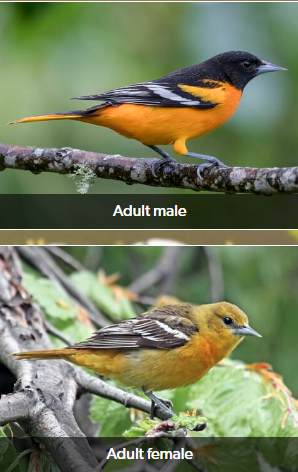
Baltimore Oriole, Icterus galbula - Baltimore Orioles are medium-sized, sturdy-bodied songbirds with thick necks and long legs. Look for their long, thick-based, pointed bills, a hallmark of the blackbird family they belong to.
Adult males are flame-orange and black, with a solid-black head and one white bar on their black wings. Females and immature males are yellow-orange on the breast, grayish on the head and back, with two bold white wing bars. They feed on insects.
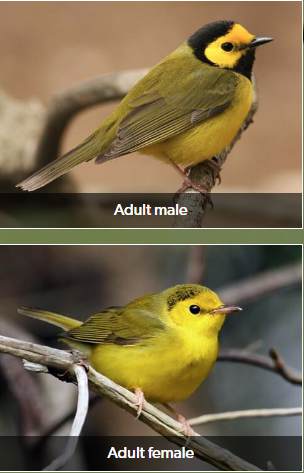
Hooded Warbler, Setophaga citrina - Hooded Warblers are small, well-proportioned birds with a straight, sharp bill. Compared to other warblers, they are fairly heavy-bodied and thick-necked.
Adult males are olive-green above and bright yellow below with a black hood and throat, a yellow forehead, and yellow cheeks. Females and immatures are also olive-green above and yellow below, but they don't have a black hood, although some adult females show an outline of a hood. Note the large black eye and white outer tail feathers that it often flashes.
Hooded Warblers are found in mature deciduous forests with a dense understory, but also uses smaller forest patches as long as there is a shrubby understory. They feed on insects.
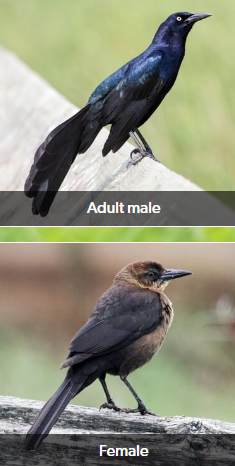
Great-tailed Grackle, Quiscalus mexicanus - Male Great-tailed Grackles are long-legged, slender blackbirds with a flat-headed profile and stout, straight bills. The male’s tapered tail is nearly as long as its body and folds into a distinctive V or keel shape. Females are about half the size of males with long, slender tails.
Male Great-tailed Grackles are iridescent black with piercing yellow eyes, and black bills and legs. Females are dark brown above, paler below, with a buff-colored throat and stripe above the eye. Juveniles have the female’s dark brown plumage, with streaked underparts and a dark eye.
Look for Great-tailed Grackles in rural and developed areas of the Midwest and West, foraging in agricultural fields and feedlots, and in suburbs including golf courses, cemeteries, parks, and neighborhood lawns. Large trees and vegetation edging marshes, lakes, and lagoons provide roosting and breeding sites. They feed on insects.
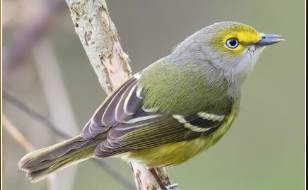
White-eyed Vireo, Vireo griseus - Small songbird with a thick, straight, and slightly hooked bill. It has a rather compact body and a thick neck. This vireo wears yellow spectacles surrounding its white eye. It has yellow-washed sides, a gray head, a white chest and throat, and 2 white wingbars. Young birds have a dark eye that turns white in their first winter or spring.
Found in deciduous scrub, overgrown pastures, old fields, forested edges, second-growth forests, and streamside thickets. In Florida, also uses mangroves. They feed on insects.
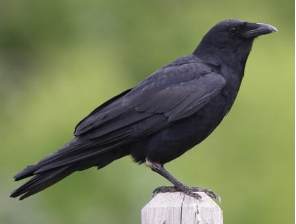
Fish Crow, Corvus ossifragus - Fish Crows are all black. Immatures are less glossy and can become brownish as their feathers wear in their first year. Fish Crows live along the coasts and inland along major freshwater rivers and lakes. You may find Fish Crows in a wide variety of habitats near water, often in towns and cities near parks, docks, and landfills. They share many habitats with American Crows. They are omnivores.
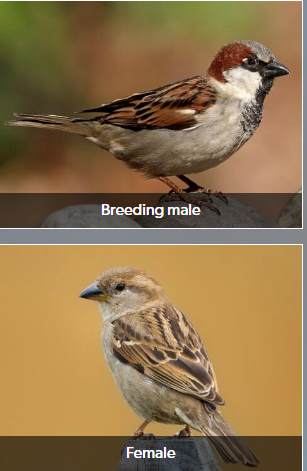
House Sparrow, Passer domesticus - House Sparrows aren’t related to other North American sparrows, and they’re differently shaped. House Sparrows are chunkier, fuller in the chest, with a larger, rounded head, shorter tail, and stouter bill than most American sparrows.
Male House Sparrows are brightly colored birds with gray heads, white cheeks, a black bib, and rufous neck – although in cities you may see some that are dull and grubby. Females are a plain buffy-brown overall with dingy gray-brown underparts. Their backs are noticeably striped with buff, black, and brown.
House Sparrows have lived around humans for centuries. Look for them on city streets, taking handouts in parks and zoos, or cheeping from a perch on your roof or trees in your yard. House Sparrows are absent from undisturbed forests and grasslands, but they’re common in countryside around farmsteads. They are omnivores.
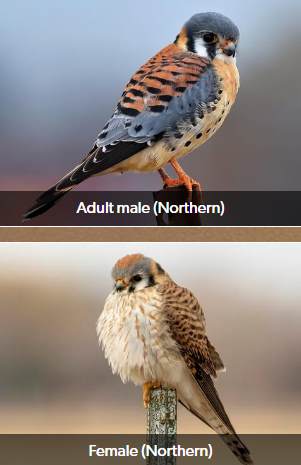
American Kestrel, Falco sparverius - The slender American Kestrel is roughly the size and shape of a Mourning Dove, although it has a larger head; longer, narrow wings; and long, square-tipped tail. In flight, the wings are often bent and the wingtips swept back.
American Kestrels are pale when seen from below and warm, rusty brown spotted with black above, with a black band near the tip of the tail. Males have slate-blue wings; females’ wings are reddish brown. Both sexes have pairs of black vertical slashes on the sides of their pale faces—sometimes called a “mustache” and a “sideburn."
American Kestrels occupy habitats ranging from deserts and grasslands to alpine meadows. You’re most likely to see them perching on telephone wires along roadsides, in open country with short vegetation and few trees. They feed on small animals.
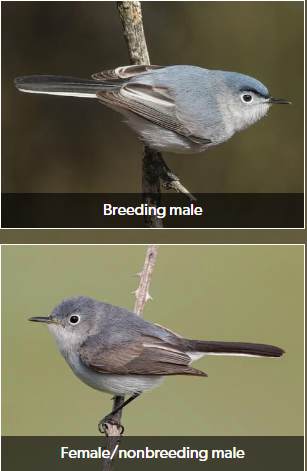
Blue-gray Gnatcatcher, Polioptila caerulea - Blue-gray Gnatcatchers are pale blue-gray birds with grayish-white underparts and a mostly black tail with white edges. The underside of the tail is mostly white. The face is highlighted by a thin but obvious white eyering. In summer, male Blue-gray Gnatcatchers sport a black ‘V’ on their foreheads extending above their eyes.
In the East, gnatcatchers breed in deciduous forests and near edges, often in moister areas. In the West, look for them in shorter woodlands and shrublands including pinyon-juniper and oak woodlands
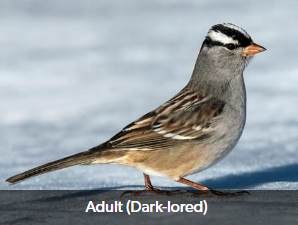
White-crowned Sparrow, Zonotrichia leucophrys - First impressions of White-crowned Sparrows tend to be of a plain, pale-gray bird; next your eye is drawn to the very bold black-and-white stripes on the head and the pale pink or yellow bill. Learn this bird's size and shape so you're ready to identify young birds that have brown, not black, markings on the head.
Look for White-crowned Sparrows in places where safe tangles of brush mix with open or grassy ground for foraging. For much of the United States, White-crowned Sparrows are most likely in winter (although two races live year round in the West, along the coast and in the mountains).
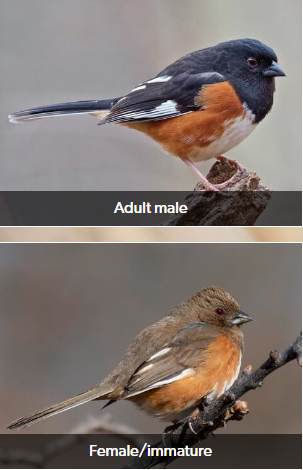
Eastern Towhee, Pipilo erythrophthalmus - Towhees are a kind of large sparrow. Look for their thick, triangular, seed-cracking bill as a tip-off they’re in the sparrow family. Also notice the chunky body and long, rounded tail.
Males are striking: bold sooty black above and on the breast, with warm rufous sides and white on the belly. Females have the same pattern, but are rich brown where the males are black.
Look for Eastern Towhees in brush, tangles, thickets, and along forest edges where there’s plenty of leaf litter for the birds to forage in. They are omnivores.
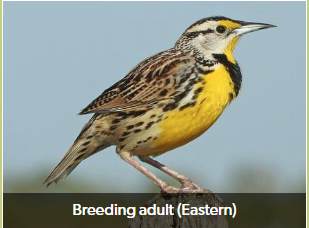
Eastern Meadowlark, Sturnella magna - Eastern Meadowlarks are chunky, medium-sized songbirds with short tails and long, spear-shaped bills. In flight, their rounded wings, short tails, and long bills help set them apart from other grassland songbirds.
Eastern Meadowlarks are pale brown marked with black, with bright-yellow underparts and a bold black V across the chest. Though most of the tail is brown with blackish barring, the outer feathers are white and conspicuous during flight.
Eastern Meadowlarks live in farm fields, grasslands, and wet fields. They nest on the ground and sing from exposed perches such as treetops, fenceposts, and utility lines. They feed on insects.
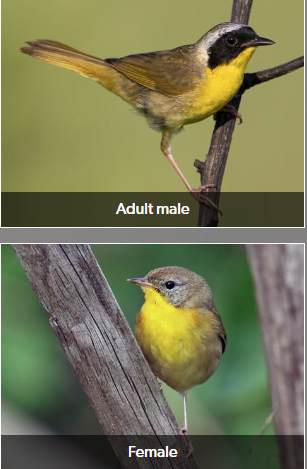
Common Yellowthroat, Geothlypis trichas (warbler) - Common Yellowthroats are small songbirds with chunky, rounded heads and medium-length, slightly rounded tails. Adult males are bright yellow below, with a sharp black face mask and olive upperparts. A thin whitish line sets off the black mask from the head and neck. Immature males show traces of the full mask of adult males. Females are a plain olive brown, usually with yellow brightening the throat and under the tail. They lack the black mask.
Yellowthroats live in open areas with thick, low vegetation, ranging from marsh to grassland to open pine forest. During migration, they use an even broader suite of habitats including backyards and forest.
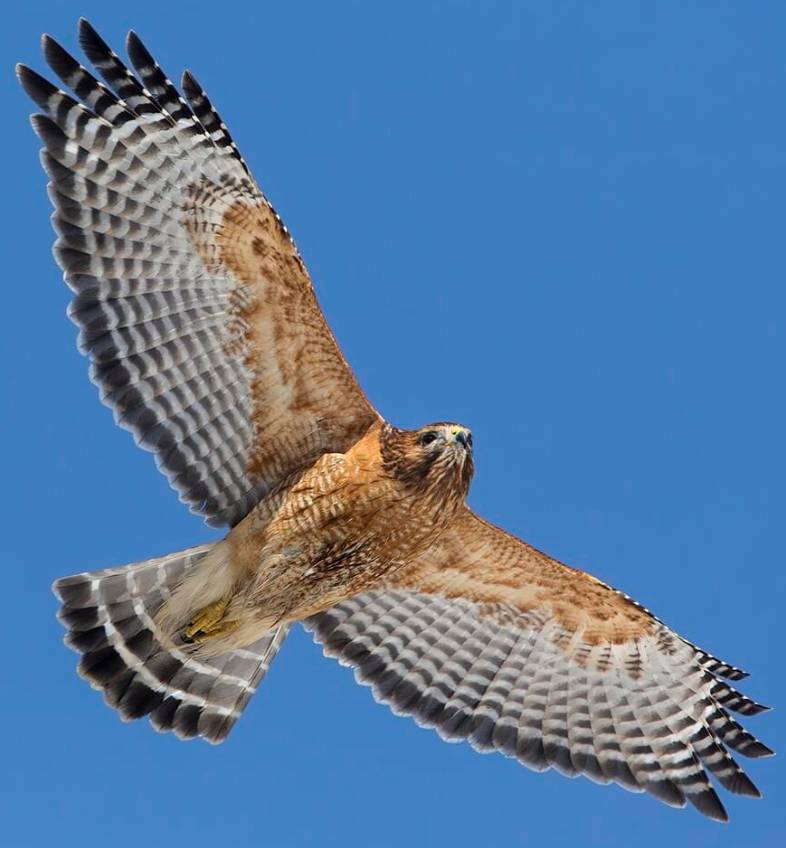
Red-shouldered Hawk, Buteo lineatus - Red-shouldered Hawks are medium-sized, with broad, rounded wings and medium-length tails that they fan out when soaring. In flight, they often glide or soar with their wingtips pushed slightly forward, imparting a distinctive, “reaching” posture. Adults are colorful hawks with dark-and-white checkered wings and warm reddish barring on the breast. The tail is black with narrow white bands. Immatures are brown above and white below streaked with brown. All ages show narrow, pale crescents near the wingtips in flight.
Look for Red-shouldered Hawks in deciduous woodlands, often near rivers and swamps. They build stick nests in a main crotch of a large tree. During migration, Red-shouldered Hawks often move high overhead along ridges or along the coast.
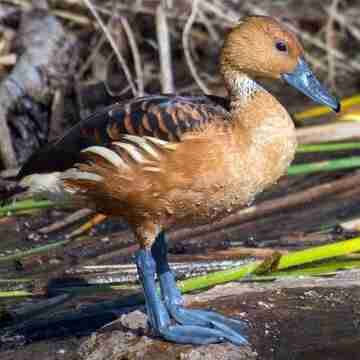
Fulvous Whistling-Duck, Dendrocygna bicolor - Fulvous Whistling-Ducks are rich cinnamon with broad black bars on the wings and back. The side of the neck has fine white stippling and the flanks have long white stripes. The tail is black, rump and undertail white, and the legs and bill are dark gray. Females have more blackish on the crown and back of neck than males.
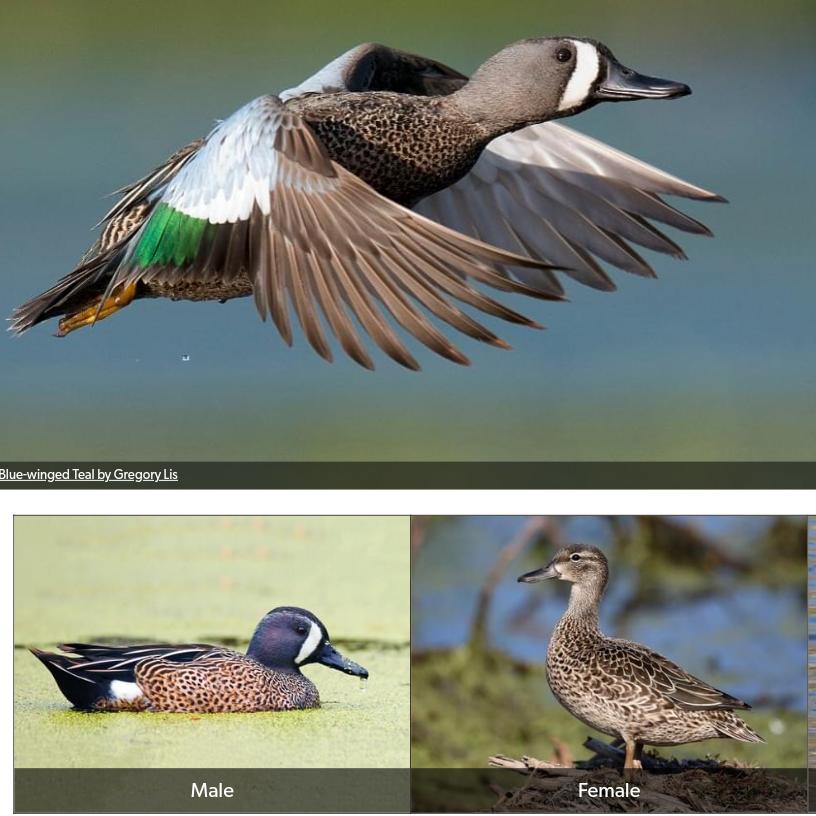
Blue-winged Teal, Spatula discors - Pairs and small groups of this tiny dabbling duck inhabit shallow ponds and wetlands across much of North America.
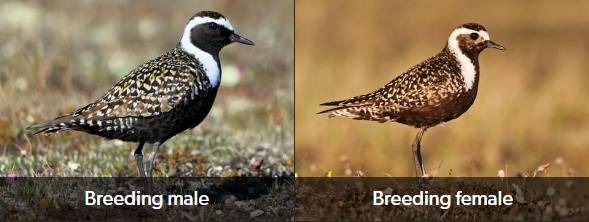
American Golden-Plover, Pluvialis dominica - Breeding birds are gold-spangled above, blackish below, with a white “scarf” extending from brow to breast sides. Juveniles and nonbreeding birds still show some gold tones above but are dingy grayish below.
Burned, plowed, and harvested agricultural fields, pastureland, sod farms, estuaries, mudflats, prairie, and tundra.
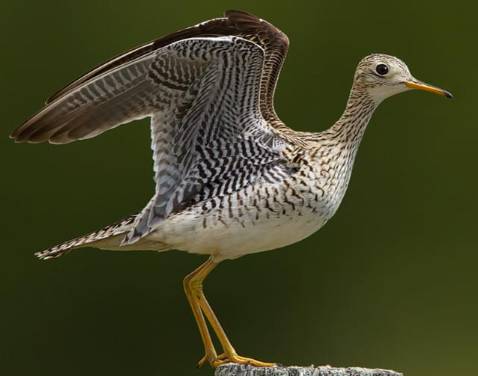
Upland Sandpiper, Bartramia longicauda - Adults and young are marbled golden brown and blackish above. They are white below, with dark streaks and chevron-shaped markings on the breast and sides. The throat is white and they have a white eyering.
Nests in native prairie, cropland, pastureland, mountain meadows, dry tundra, and similar grassland environments. Migrates quickly to wintering areas in grasslands called pampas and llanos in South America, similar in structure to their nesting habitat. Migrants often stop over in agricultural fields
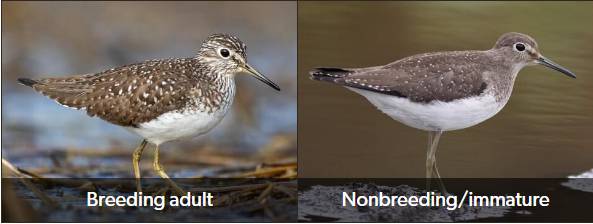
Solitary Sandpiper, Tringa solitaria - Dark olive-brown above with a white eyering; pale below. In breeding plumage, the head and breast show dark stippling and the upperparts are neatly spotted with white. In nonbreeding plumage the back is mostly unspotted and the breast is washed with brown. The legs are olive. Dark underwings contrast sharply with white belly in flight.
Solitary Sandpipers nest in arctic muskeg bogs. Migrating and wintering birds use wooded swamps, river edges, bogs, lakes, ponds, ditches, pastures, rice fields, and wet meadows.
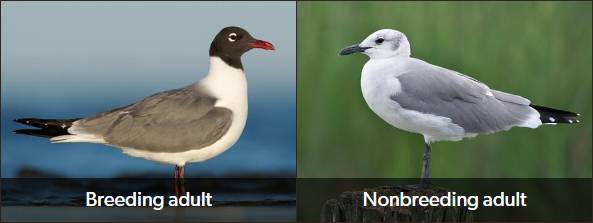
Laughing Gull, Leucophaeus atricilla - Laughing Gulls are medium-sized gulls with fairly long wings and long legs that impart a graceful look when they are flying or walking. They have stout, fairly long bills.
Laughing Gulls are a coastal species and are only occasionally seen very far inland. Look for them in plowed fields, garbage dumps, parking lots, and shorelines. They nest, often in large numbers, on islands near the shore but safely isolated from terrestrial predators.

Yellow-crowned Night Heron, Nyctanassa violacea - Yellow-crowned Night Herons are fairly small herons with stocky bodies and short, thick necks, and short legs. They have large, blocky heads with thick, relatively short bills. In flight, the wings are broad and rounded.
They are most common in coastal wetlands barrier islands, saltmarshes, drainage ditches, and mangroves; they also occur inland along bottomland forests, swamps, and sometimes wet lawns or fields.
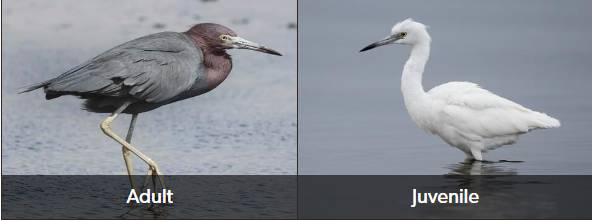
Little Blue Heron, Egretta caerulea - This is a fairly small heron with a slight body, slender neck, and fairly long legs. It has rounded wings, and a long, straight, spearlike bill that is thick at the base.
Look for Little Blue Herons on quiet waters ranging from tidal flats and estuaries to streams, swamps, and flooded fields. They are usually found in only small numbers at any one water body, often tucked into hidden corners.

Western Cattle Egret, Bubulcus ibis - Compared with other herons, Western Cattle Egrets are noticeably small and compact. They have relatively short legs and a short thick neck. The straight, daggerlike bill is shorter and thicker than other herons. They have medium-length, broad, rounded wings.
They forage in flocks in upland areas such as pastures and fields, generally focusing on drier habitats than other species of white herons.